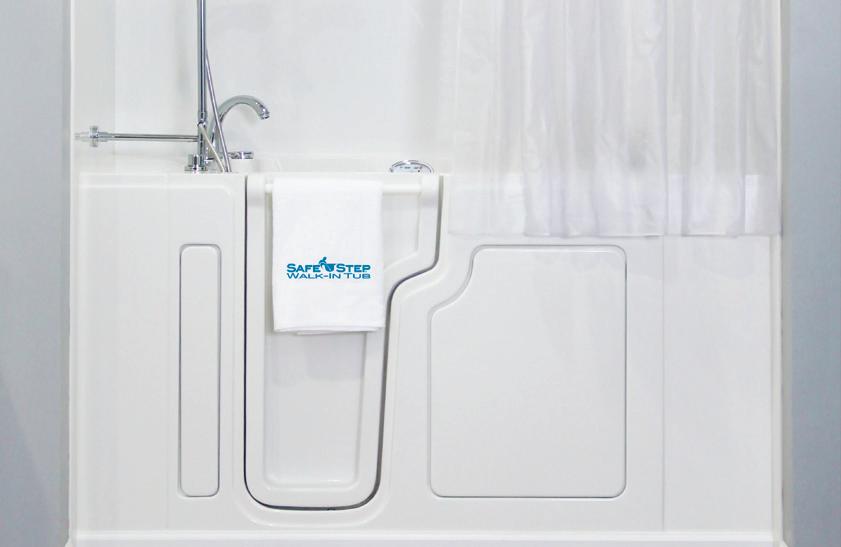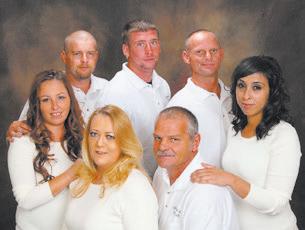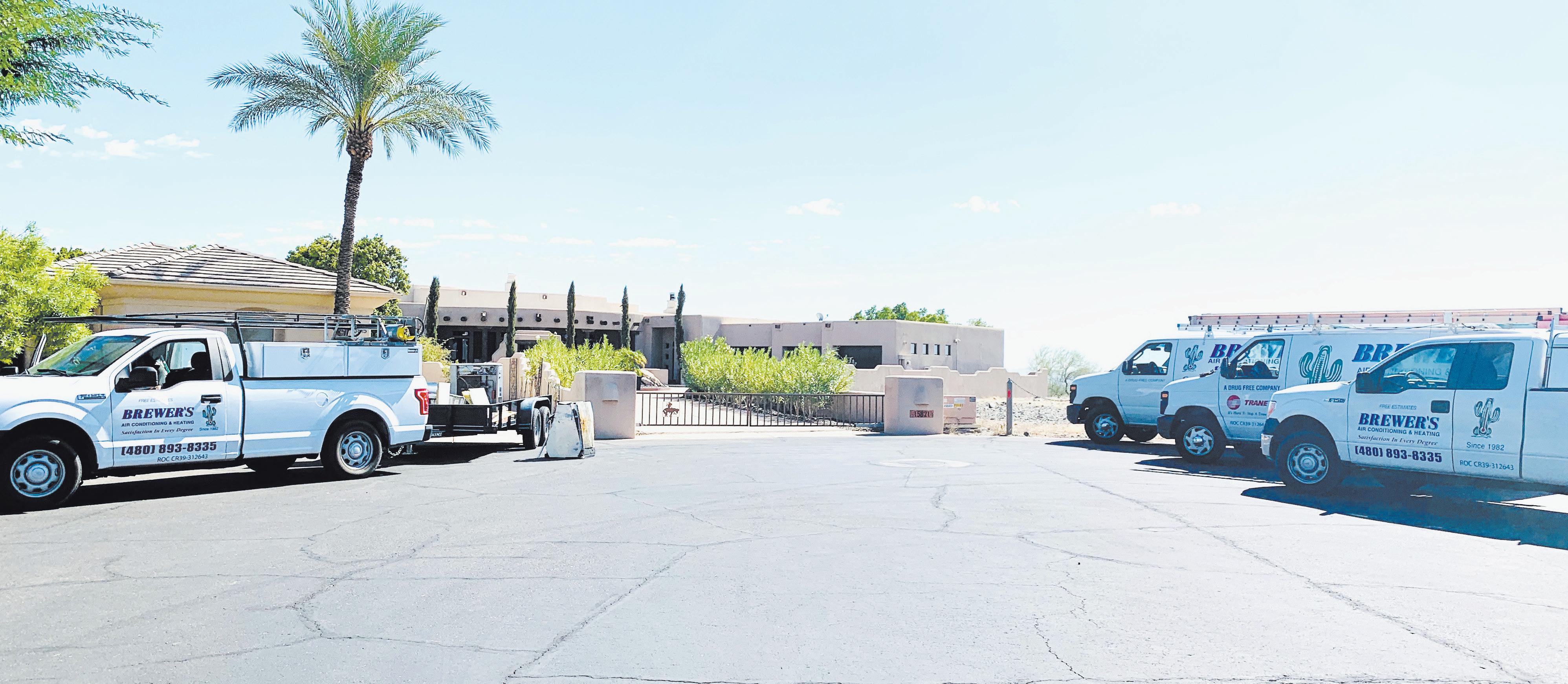




Five








Five


Following a marathon six-hour meeting Aug. 3 that stretched beyond midnight, the Phoenix Planning Commission approved two controversial Zoning Code amendments that both the Ahwatukee Foothills and Desert View village planning committees rejected and that other VPCs either voted down or approved with recommendations for changes.
The measures on Sept. 6 go to City Council, which has the option of adopting them, making further changes or sending them
back to the city Planning and Development Department for further study.
Some council members in meetings a few months ago expressed urgency in adopting the measures in an effort to meet the city’s goal of building or preserving 50,000 “affordable housing” units by 2030.
The only problem, as noted in frequent VPC meetings and last week’s Commission session, is the lack of consensus on what “affordable” means.
The meeting last Thursday was prolonged by a lengthy agenda that put the two zoning proposals toward the end of a 17-item agen-
da. Two of the other items each generated hour-long debates on unrelated projects in two different parts of the city.
The discussions of both zoning amendments also were lengthy as proponents and opponents weighed in.
One measure would allow single-family homeowners to build a detached home in their backyard that could be no bigger than 75% of the square footage of the main house.
The Ahwatukee and Desert View VPCs opposed that amendment while six okayed
see PLANNING page 9
As St. John Bosco Catholic School today, Aug. 9, becomes the last Ahwatukee school to start the 2023-24 school year, returning students will find some significant changes from the last time they were on the 48th Street campus.
For one thing, there’s more of them. The Pre-K-8 school will have 97 new students this school year, bringing enrollment to an all-time high of 440 students that Principal Jamie Bescak said could rise to 450.
K-6 students will be learning English Language Arts through a new curriculum that cost $100,000 of the $170,000 that St. John
see BOSCO page 24

























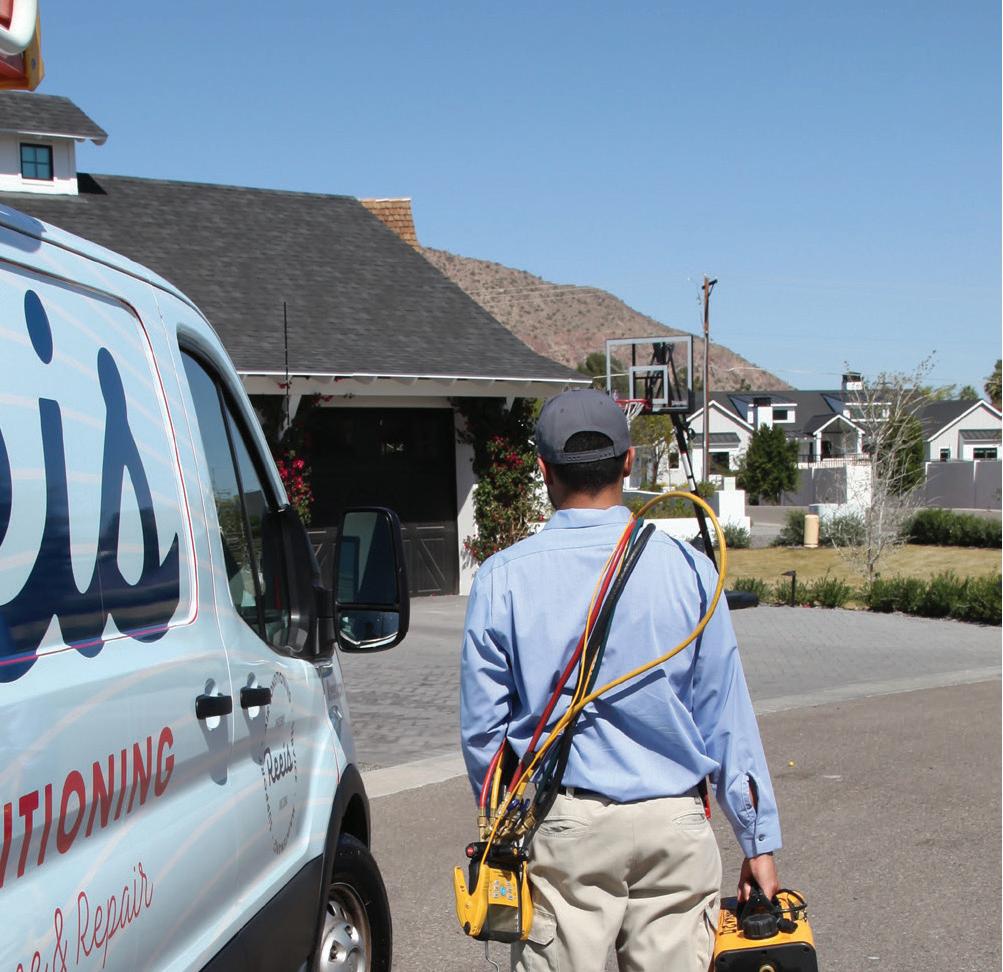















The Ahwatukee Foothills News is published every Wednesday and distributed free of charge to homes and in single-copy locations throughout Ahwatukee Foothills.
Times Media Group:
1900 W. Broadway Road, Tempe, Arizona, 85282
Main number: 480-898-6500
Advertising: 480-898-5624
Circulation service: 480-898-5641
Steve T. Strickbine VICE PRESIDENT
Michael Hiatt
National Advertising Director
Zac Reynolds 480-898-5603 zac@ahwatukee.com
Advertising Sales Representatives:
Laura Meehan, 480-898-7904, | lmeehan@ahwatukee.com
Katie Mueller, 480-898-7909 kmueller@TimesLocalMedia.com
Classifieds/Inside Sales:
TJ Higgins, 480-898-5902 tjhiggins@TimesLocalMedia.com
Steve Insalaco, 480-898-5635 sinsalaco@TimesLocalMedia.com
NEWS STAFF
Executive Editor:
Paul Maryniak, 480-898-5647 pmaryniak@ahwatukee..com
GetOut Editor: Alex Gallagher | 843-696-6442 | agallagher@TimesLocalMedia.com
Sports Editor:
Zach Alvira 480-898-5630 | zalvira@TimesLocalMedia.com
Production Manager: Courtney Oldham | 480-898-5617 production@TimesLocalMedia.com
Designer: Ruth Carlton | rcarlton@TimesLocalMedia.com
Photographer:
David Minton | dminton@TimesLocalMedia.com
Reporters:
Cecilia Chan. 480-898-5613 | cchan@@TimesLocalMedia.com
Circulation Director:
Aaron Kolodny 480-898-5641 | aaron@TimesLocalMedia.com
Ahwatukee Foothills News is distributed by AZ Integrated Media, a circulation service company owned by Times Media Group. The public is limited to one copy per reader. For circulation services please contact Aaron Kolodny at aaron@TimesLocalMedia.com.

To start or stop delivery of the paper, please visit: https://timespublications.com/phoenix/ or call 480-898-7901
To get your free online editiona subscription, please visit: https://www.ahwatukee.com/e-subscribe/
WRITE A LETTER
To submit a letter, please include your full name. Our policy is not to run anonymous letters. Please keep the length to 300 words. Letters will be run on a space-available basis. Please send your contributions to pmaryniak@ahwatukee.com.
The Ahwatukee Foothills News expresses its opinion. Opinions expressed in guest commentaries, perspectives, cartoons or letters to the editor are those of the author.
The content and claims of any advertisement are the sole responsibility of the advertiser. The Ahwatukee Foothills News assumes no responsibility for the claims or content of any advertisement.
© 2023 Strickbine Publishing, Inc.
Whether new academic achievement goals should be part of Tempe Union High School District Superintendent Dr. Kevin Mendivil’s performance pay triggered a polite but tense argument at the district Governing Board’s meeting Aug. 2.
Board member Sarah James' request set off the lengthy discussion in which at least one board member criticized her proposal while board President Armando Montero tried to move the discussion behind closed doors to achieve a compromise.
While the discussion continued for nearly an hour without a resolution, the board scheduled a special meeting Aug. 7, indicating it would start as a public session but could move behind closed doors.
The reason for the Aug. 7 meeting was listed as “for the purpose of deciding whether to go into Executive Session.” The meeting was slated to be held after the print deadline for the Ahwatukee Foothills News.
James’ proposal to more closely tie the goal Mendivil wrote for his performance pay for this semester was tied to the new goals the board and district administration are setting for teachers and other staff.
Those goals are related to improving overall student scores on academic achievement tests, particular for freshmen and juniors who take one of the versions of the ACT test.
Those goals are especially critical to elevating proficiency among numerous subgroups in the district, including English learners, Hispanics, African Americans and students with disabilities – all of whom showed a far greater lack of proficiency in math and English Language Arts than the student body as a whole.
The tests for both freshmen and jusee BOARD page 4









BOARD from page 3
niors measured students’ proficiency in English Language Arts and math while juniors also are tested for proficiency in science.
Juniors overall performed better in 2022-23 than the previous year in Arizona’s basic test of academic proficiency in English Language Arts and math.
But individual high school's scores painted a different picture, showing wide disparities in results among the district’s six campuses and online learning program.
Likewise, results were a mixed bag in the ACT Aspire test of freshmen’s proficiency in English Language Arts and math.
Moreover, while 56% of all Tempe Union juniors this year showed a lack of proficiency in math, student subgroups’ averages were far worse.
Results showed that 75% of Native American juniors were not proficient in math. Other percentages showing a lack of proficiency included: Hispanics, 68%; students with disabilities, 94%; English language learners, 96%; and African Americans, 80%.
For English Language Arts, while 46%


of all district students showed they were not proficient, twice that many English learners were not proficient.
A lack of proficiency in English for other so-called “marginalized” groups included 90% of students with disabilities compared to 43% of students who are not disabled; 76% of Native Americans, 59% of Hispanics and 67% of African Americans.
The district’s goals introduced at last week’s meeting for the new school year include increasing the number of



all students showing proficiency in the ACT ELA, science and math by 5% for all students and 10% for “marginalized students.”
The district also would be committing to reductions in absence rates and increased completions of applications for federal financial aid for higher education, according to the new goals.
James’ move came during a discussion of Mendivil’s proposed performance goal for himself for this semester.
He proposed that by December, he would present a revised strategic plan that would establish a way of monitoring the district’s progress on improving students’ academic achievement, social emotional learning and on equity in discipline.
A second component involved creating environments that would “ensure that all TUHSD graduates are afforded multiple post-secondary opportunities for success upon graduation.”
The board’s conversation started to get tense when board member Andres Barraza asked whether a discussion of the superintendent’s performance goal could be held in executive discussion.
After district legal counsel Jordan El-

James’ request. (YouTube)
lel said it could, Montero asked James if she preferred to go behind closed doors to discuss her thoughts on amending Mendivil’s firsts semester goal.
Instead, James began explaining that she wanted some kind of showing by Mendivil of progress related to the new goals, even if it just involved reducing high absenteeism rates.
James noted that on Aug. 16, the board


BOARD from page 4 will adopt the new performance and attendance goals “that we’re going to hold our staff and teachers accountable for and I think there are things that we can look at as superintendent, you can dig into and help push along between now and December.”
Vice President Amanda Steele asked James if she was referring to Mendivil’s planned “road show” at all campuses to explain the student achievement goals.
“He wants to go around to all the schools and sell this,” Steele said of Mendivil. “So right now, how can we measure what he’s selling and the buyin at the different sites?”
Steele then said the board could later set a goal for Mendivil to “lead the implementation of a comprehensive three- phase plan to improve student outcomes and close opportunity gaps for historically marginalized students in alignment with the recently adopted board goals.”
James expressed frustration over what seemed to be the board’s reluctance to align the superintendent’s goal this semester more directly to the performance goals for academic improvement that teachers and district staff will have.
“A year ago we had the same or similar goal present,” she said. “We had the same conversations and we’ve been talking about aligning. I feel like I’ve been transparent in conversations about my feelings about superintendent goals and what they should look like. …That’s why I’m going to give some pushback because I know we are going to ask our students to do a lot this year starting very soon.”
“How can we make this thing measurable directly to our superintendent in favor of that?” James continued, noting she repeatedly asked in the past for an executive session to further discuss the issue.
Montero suggested a compromise, pointing to Steele’s suggestion that some measures be placed into Mendivil’s goals later in the school year. “I want to find a happy medium, a compromise so all five of us can agree on,” he said.
Mendivil said that regardless of how the board voted on the goal that was originally proposed for this semester, “I’m very aware of my responsibilities.”
Barraza then indirectly criticized James, stating,, “I’m just wondering why at the very last minute” she was lobbying
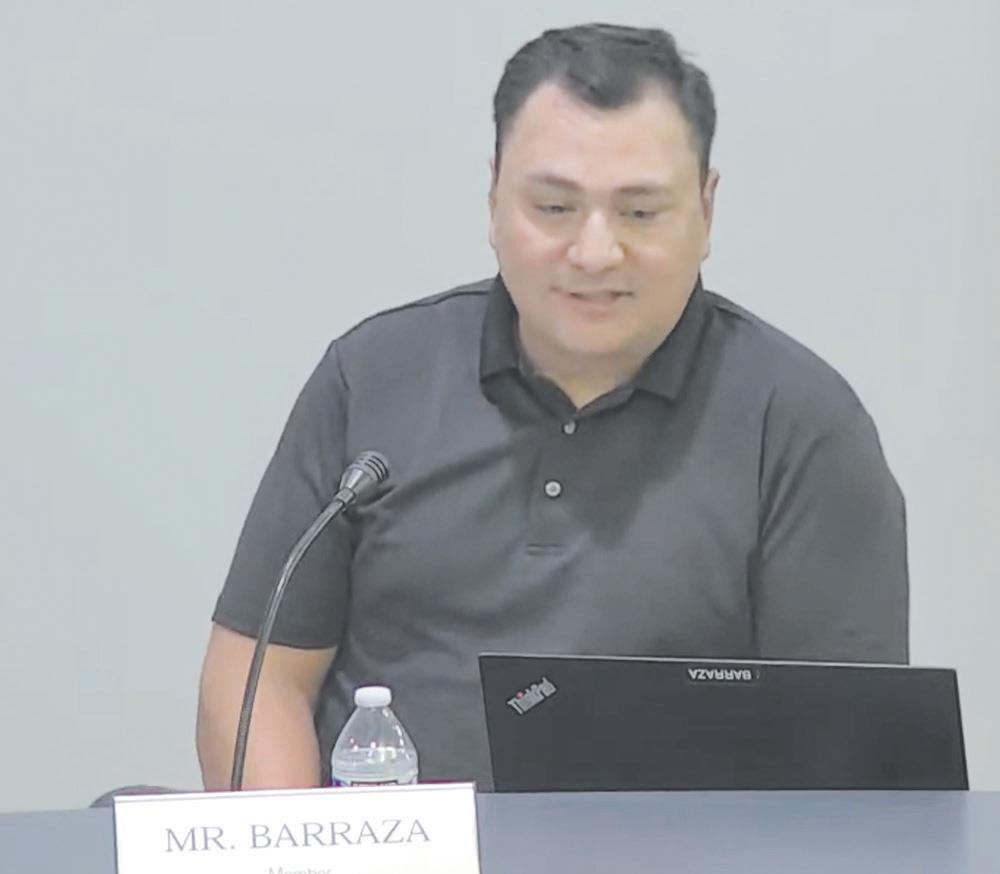
to rework Mendivil’s goal for this semester.
“Why didn’t you work and why hasn’t it been worked on with the superintendent?” Barraza asked James. “I think it’s odd that we’re still so unsure and I don’t think that the 16th is going to bring any clarity because it’s a new day.
“This was very sloppy the way the board handled this,” Barraza continued.
Montero countered, “These are conversations that are bound to be messy because that’s what changes are. Changes are not streamlined and pretty.”
But Barraza replied, "I’m saying that this is something that should have been worked on long ago….I think it’s unfair to Dr. Mendivil and the executive team to not give them clarity.
“But I have to say how I feel about not moving forward and continually pushing these things down. It’s not just this issue. It’s other issues we keep pushing….This is ridiculous at this point.”
Mendivil offered to redraft his goal for this semester to “have something that will be agreeable to hopefully everybody and move on.”
But earlier Mendivil also cautioned that the new performance goals for district teachers and other staff would represent a significant change for them.
“I want to encourage our staff and our site leadership to embrace and hold themselves accountable and be proud of the work that they will be embarking on to move these percentages with these particular student groups,” he said, adding:
“I don’t want to scare them off because this is something very new to them, I think, in many instances in terms of how discreet and focused they are going to be working on this.”




























Phoenix Police officials last week said they are continuing to cooperate with a wide-ranging U.S. Justice Department probe into officers’ practices.
The now 2-year-old “Pattern or Practice” investigation – which has cost city taxpayers over $2 million – is focusing on five areas involving officers’ engagements with civilians.
training sessions with the department,” Phoenix Police said last week, conceding it has navigated “challenges” involving “sensitive law enforcement information which complied with FBI standards.”
“The City of Phoenix follows FBI rules for Criminal Justice Information Services, which regulate the sharing of sensitive information like fingerprints, documents, and other evidence belonging to those involved in the criminal justice process,” Phoenix Police said, adding it resolved the disagreement with federal authorities two years ago..







Those areas include whether the department: uses excessive force, including deadly force; engages in discriminatory practices; retaliates against protestors or demonstrators; it deals appropriately with behavioral health issues on calls with people in mental crisis; and violates the rights of unsheltered people by confiscating their belongings.


“City and police leaders have provided the DOJ with documents, videos, interviews, ride-a-longs, and access to
“Since resolving the issue, the City of Phoenix has provided more than 20,000 body worn camera videos and 80,000 requested documents to DOJ investigators,” police said.
It said during a seventh in-person visit to Phoenix, investigators interviewed
see
page 7



At the same time Phoenix Police disclosed the status of a federal investigation into its operation, the department released statistics for the first six months of 2023 that show overall violent crime is down 2% from the same time period last year with homicides and robberies plummeting by over 10%. The clearance rate through the first six months of 2023 is 96.6%. (Phoenix Police)
Community Assistance Program and Field Training Officer program staffers.
“Additionally, the DOJ took part in a learning session to better understand the City of Phoenix’s public records request process,” police said.
“During the four-day site visit in April, the DOJ also spent significant time at the Phoenix Regional Police Academy where they observed small team tactics and high-risk vehicle stop training.
Last year investigators spent 200 hours on ride-alongs and “touring and observing multiple precincts across the city,” the report stated and shadowed school resource and Community Action officers and attended supervisor leadership and use of force training sessions.
“In between site visits, the City of Phoenix routinely met virtually with DOJ attorneys to provide clarification on documents shared and technology used to capture data,” the statement said.
Saying the department “welcomes the next steps in this process and continues open dialogue with DOJ leadership,” Phoenix Police also said residents can
learn more about the investigation at phoenix.gov/police/doj.
The investigation began Aug. 5, 2021 when the Justice Department announced a civil – not a criminal – probe, the 71st such federal investigation conducted un the 1994 Violent Crime Control and Law Enforcement Act signed by President Bill Clinton.
Phoenix officials have periodically reported to City Council on the status of the investigation, noting several such probes of other cities have resulted in years-long monitoring of those municipalities’ police departments and have cost their taxpayers tens of millions of dollars.
The probe includes a review of whether Phoenix Police retaliate protestors and others “for conduct protected by the First Amendment.”
That potential exists in the Phoenix probe, as city officials have state “If the investigation does reveal what the DOJ considers to be patterns or practices of misconduct, it will articulate what those are, and create recommended remedial measures to correct them.”















































Under the Zoning Code amendments that the Phoenix Planning Commission is recommending that City Council approve on Sept. 6 is one that would allow single-family homeowners to build a detached home in their back yard that could be no bigger than 75% of the size of the main house. It would not prevent construction of other structures, such as a tool shed. (City of Phoenix)
PLANNING from page 1
it with recommendations for modifications.
The Ahwatukee VPC raised numerous concerns about the amendment allowing so-called “accessory dwelling units” or “casitas.”
Among those concerns was the prospect that ADUs will trigger frequent neighborhood disputes over street parking because the amendment does not require additional parking on the premises.
More significantly, VPC members also were concerned – and so were a few Planning Commission members – that the amendment could pave the way for a rash of pricey short-term rental properties that would defeat the city’s intent – namely, increasing the number of affordable homes in the city.
Parking proposal narrowed
The other measure reduced the required minimum number of parking spaces in apartment complexes – which was opposed by 10 of Phoenix’s 15 VPCs, including Ahwatukee and Desert View.
One Planning Commission member was not impressed by that lopsided vote, stating that it made no sense to have city staff further study the issue and go back to the committees for another review.
“The goal of villages is not to get every village in agreement,” he said. “It is a signaling mechanism. The villages have had their opportunity to give their
message. Some of their messages are no, some of their messages are yes.
“Now it’s up to us to determine what we want to do with that information and ultimately up to the council to determine what they want to do with our recommendation.
“The fact that villages said ‘no’ does not mean that we need to go back through that process. It just impacts the likelihood of whether Council will say ‘yes’ or not. And so from my perspective, we’ve heard the case. We’ve discussed it fairly extensively. I think we vote on it. If you want to vote no, you can do that…I just don’t know that there’s necessarily more benefit to going back through the process.
“I would actually ask instead that people that can continue to communicate throughout the process between now and council because it will be several weeks before that case is actually heard.”
In acknowledging the widespread opposition to the parking measure, the Commission made a key change by striking its citywide application.
It also eliminated the reductions for projects in areas designated for “affordable housing” because no one can satisfactorily define “affordable.”
Instead, the Commission limited the reduction of spaces to only certain areas of the city designated for “urban walkability” and infill development on the

















4 BR / 2.5 BA / 2,283 SQFT
Enjoy the privacy of this premium hillside view lot. Just completed new carpet and interior paint.
Listed For $497,500
5 BR / 3 BA / 2,736 SQ FT
Spacious former UDC model home with South Mountain views. Private backyard with large pool.
Listed for $625,000
5 BR / 3.5 BA / 5,079 SQFT
Impressive custom with mountain views. Abundant amenities including professional sport court in private backyard.
Listed for $1,325,000
3 BR / 2 BA / 1,500 SQFT
Great remodel with superb updates in kitchen and baths. 2017/2018 roof. 2017 exterior paint. 2016 HVAC.
Listed for $489,500
5 BR / 3 BA / 3,394 SQFT
Complete remodel. New roof, two AC units, flooring, kitchen, baths, plumbing and more.
Listed for $799,000
5 BR / 4.5 BA / 4,391 SQFT
Superb single level with detached casita. Shutters, travertine and laminate flooring. New roof in 2022.
Listed for $1,225,000








Listed
plan. FIVE bedrooms and THREE bathrooms. 1998 sf. Kitchen boasts espresso colored cabinets, granite counter tops, large center island / breakfast bar, Whirlpool stainless steel appliances and pantry. 20x20 porcelain tile throughout with carpet in bedrooms only! Smart home technology. 14 seer HVAC unit. Large master suite with walk in closet, double sinks and walk in shower. Two of the secondary bedrooms also have walk in closets. Faux wood blinds throughout. Covered back patio. NORTH FACING BACK YARD! Low maintenance front and backyard landscaping.
PLANNING from page 9 theory that tenants in such neighborhoods would be less reliant on motor vehicles to get around.
The Ahwatukee VPC had taken similar action despite city planners’ advice that it could only suggest a change but not formally approve a different amendment from the one they put before it.
The reduction in minimum parking spaces drew numerous citizen endorsements at the commission’s meeting with 10 of 12 speakers urging its approval.
Two speakers gave the identical speeches they made before the Ahwatukee VPC two weeks ago.
Proponents, including some owners and developers of multifamily projects, disputed opponents’ assertions that fewer parking spaces would create havoc in nearby residential neighborhoods because the complexes’ tenants would be forced to park on their streets.
“This idea that developers are simply going to do whatever they can get away with is inaccurate” said Dan Clark, chair of the Phoenix Historic Preservation Commission.
Process assailed
He said current parking requirements were forcing developers to “waste” hundreds of thousands of dollars on asphalt that could be used to develop more housing units.
Other speakers added that increased the city’s heat island effect as well.
But the Neighborhood Coalition of Greater Phoenix – which had opposed the original amendments and had lobbied all city VPCs to reject the city’s parking amendment – hailed the changes the Commission made.
In a statement, the coalition also criticized the process city planners used to advance both Zoning Code amendments.


It cited the city’s failure to get neighborhood groups’ input while conferring with special interest groups, mainly those associated with multifamily project development.
Ahwatukee VPC members had voiced similar criticisms during their July 24 consideration of the amendments, with one saying that they looked as if they had been hatched in an office cubicle by workers who cared little about the changes’ impact on neighborhoods.
“The commission’s recommendation is not binding on the City Council but,
together with votes by most of the city’s village planning committees to oppose the parking reduction proposal, should serve as a clear caution flag,” said Coalition member Larry Whitesell, who also co-chairs a neighborhood association.
“Diverse groups of residents worked together to come up with solutions that reflect the needs of a larger group of residents across the city,” Whitesell said.
“Proponents of the overall parking proposal argued that developers would build additional multifamily housing units if the parking requirements were relaxed,” the Neighborhood Coalition said. “However, neighborhood leaders and other critics of the proposal said it was ‘severely flawed.’”
Neighborhood Coalition President Neal Haddad added:
“These proposals are of interest to a great many people across a vast swath of neighborhoods in Phoenix. There were no opportunities for citizens to share their viewpoints prior to these changes being presented in a formal setting.
“Allowing people two minutes to speak on a document that’s 200 pages long is not good governance. We can do better.”
The Coalition noted that VPC and Commission discussions showed that applying the parking reductions citywide “didn’t take into consideration differences in various areas’ housing needs and transit availability and failed to adequately serve the needs of residents of affordable housing.”
Indeed, Ahwatukee VPC member Mike Schiller last month noted that when city officials two years ago presented their plans for expanding mass transit in the city, Ahwatukee wasn’t even on their map.
The Planning Commission also rejected suggestions on the code amendment that would allow single-family homeowners to build in their backyard a small detached home, formally called an “accessory dwelling unit (ADU) and informally a “casita.”
Questions remain on casitas
On advice from city planners, the commission declined to address concerns about homeowners using the ADUs as short-term rentals.
Suggestions had been made to include a 30-day minimum rental period for ADUs.
The commission also followed staff advice that it was not necessary to clear see



























































Gov. Katie Hobbs signed legislation last week to allow Maricopa County voters to decide on extending a half-cent sales tax for transportation projects, setting the stage for the fight to come at the ballot box – and hitting Phoenix hard.
While the deal provides hope that voters next year will extend a tax that has poured millions of dollars into road and mass transit improvements in Phoenix and its counterparts in the county, it also delivers a more than $70 million annual financial hit and threatens to derail the city’s plans to expand light rail.
The measure before voters will ban spending any money on light rail expansion. Moreover, to get most Republican legislators to approve the measure, Hobbs agreed to sign a separate bill that prevents municipalities from imposing a tax on rent, beginning in calendar year 2025.
That ban will cost Phoenix at least $70 million in annual rent tax revenue, according to the state Revenue Department. That’s the highest hit among all Arizona municipalities that tax rent.
Phoenix Mayor Kate Gallego praised passage of the tax vote bill but understandably wasn’t happy with what it took to get there.
“I am glad that our robust, unanimously approved transportation plan will finally reach the voters of Maricopa County,” she said in a statement released last week, saying extension of the tax would “ultimately mean that we can deliver on improved and expanded transit and transportation services that connect county residents to jobs, education, and more.”
But her statement added:
“While it’s exciting that we’ve advanced Proposition 400, I remain disappointed that this critical legislation was coupled with an effort to cut revenue to cities, including Phoenix, as soon as in the next budget year.
“As such, I cannot and will not support any action that would take away the power of cities to levy a residential rental tax, as this revenue is how we fund public safety hiring, improvements to parks

and preserves, and neighborhood public safety grants.
“If the Legislature wishes to push forward attempts to effectively defund our police and firefighters, I strongly urge them to come to the table and discuss how they can help us recoup the lost funding.”
Similar condemnations of the rental tax abolition and demands that the Legislature compensate them were made by Mesa, which took a $20 million rental tax hit; Scottsdale, which will lose nearly $15 million; Chandler, $9.8 million and Gilbert, $7 million.
The Arizona League of Cities and Towns had begged Hobbs to veto the bill and said it wants lawmakers and the governor to essentially reimburse them for the revenues they will be losing.
That move, which won’t go into effect until the new fiscal year begins next July 1, will take away more than $230 million a year in revenue that a majority of the state’s 91 cities and towns collect, according to a lobbyist for the League of Arizona Cities and Towns.
“The 75 cities that are going to be directly impacted by this, they’ve only got two options should this bill be signed,’’ the League’s Tom Savage said. “They’re going to have to either cut services, or they’re going to have to increase local taxes to make up for this loss.’’
But they are likely to face hostility from
is levied on top of rents, at rates that average 2.4%.
“This is (money) to help people put food on the table, give them an extra tank of gas in the car,’’ said Senate President Warren Petersen, R-Gilbert. “And we are ready to provide relief.”
Senate Majority Leader Mitzi Epstein, a Democrat whose district includes Ahwatukee, said even if landlords no longer charge the tax, they will simply raise their rates knowing that’s what tenants are willing to pay.
Former Gilbert Mayor John Lewis, now president/CEO of the PHX East Valley Partnership, a strong proponent of the transportation tax extension, said the compromise showed “courageous leadership on the part of many.”
the Republicans who control the Legislature who have championed the repeal.
Senate Majority Leader Sonny Borrelli, R-Lake Havasu City, put it most succinctly: He responded to a query about the League’s request with a one-icon response of a thumb down.
House Speaker Ben Toma, R-Peoria, was cool to the whole idea.
“Governments always want to be held harmless from various economic impacts, including inflation,’’ he said., adding that governments rarely recognize the impact of inflation on taxpayers, including in rising rents.
House Majority Whip Teresa Martinez said, “I don’t know if the state has enough money to backfill.”
“We want to make sure that our communities and our cities are not in a pinch,’’ Martinez said. “But we also want to make sure that the (state) taxpayers can have some of their money back.’’
At the very least, she said, it will take time to figure out how much the affected cities come up short and how much the state is collecting in revenues.
Senate Republicans called a news conference to crow about the rental bill, saying cities were flush with cash and criticizing them for not voluntarily eliminating the rental tax.
And they said they wanted to help lowincome renters during a period of high inflation by getting rid of the tax, which
“No one ended up receiving what they originally wanted, but leaders knew that with our growth, we needed funds to build for the future and a Transportation Plan to guide us,” Lewis said.
In a prepared statement, the governor said the levy “will secure our economic future and give every Arizonan an opportunity to succeed in our thriving economy.’’
She also crowed about the fact that the measure gained bipartisan approval, attracting more than half the Republican lawmakers and all Democrats but one.
But all that the key provision of the legislation actually does is authorize county supervisors to call a special election, presumably in 2024, to give voters the last word on extending the levy 20 years, to 2045.
Proponents have characterized the measure as simply giving voters the opportunity to keep in place the half-cent tax first approved 1985.
State lawmakers approved a new vote just last year, only to have it vetoed by then-Gov. Doug Ducey, sending the measure back to a new Legislature that is more fiscally conservative.
Negotiations resulted in the bill that she signed but that includes some significant curbs on how the money could be used.
The transportation tax bill caps mass transit spending at 37% of the estimated


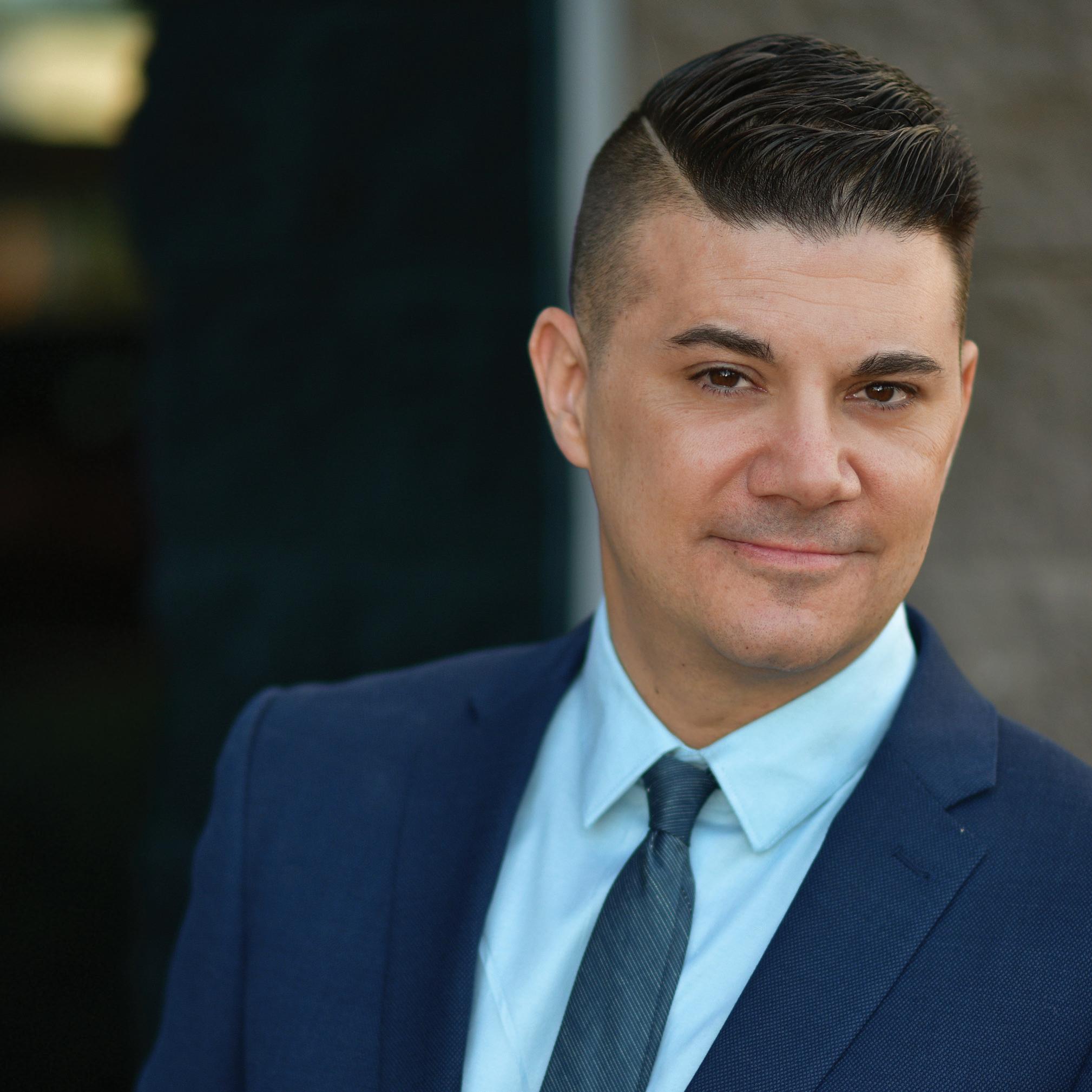





The number of people dying in vehicle crashes in Arizona increased for the third straight year in 2022 with about three fatalities a day, according to the latest state report.
The 1,294 traffic fatalities across the state last year represented an increase of 8.6% over 2021, the Arizona Department of Transportation said.
Its annual Arizona Motor Vehicle Crash Facts, released last week, faulted speed as the continuing leading factor in fatal and serious crashes, causing 426 deaths and 20,069 injuries during 2022.
“We are seeing an increase in both traffic and fatal collisions,” said Maj. Jason Leonard, chief of staff of the Arizona Department of Public Safety’s Highway Patrol Division.
“Most of these collisions are preventable if drivers do two things – avoid distractions and remain focused on the task of driving and be patient and drive within the law, especially relating to speed, passing and distracted driving.”
Overall, the 2022 traffic fatality total is the second-highest ever recorded in Arizona and only slightly behind the record 1,301 deaths recorded in 2006.
Maricopa County saw 660 fatal vehicle crashes in 2022, compared with 603 in 2021.
Phoenix, Chandler, Mesa, Gilbert, Scottsdale and Queen Creek each followed the state and county lead with more fatal crashes than in 2021.
For 2022, Phoenix reported 282 fatal crashes and 301 deaths; Chandler, 19 fatal crashes and 20 deaths; Mesa, 53 crashes and 55 deaths; Gilbert, 18 crashes and 19 deaths; Scottsdale, 16 crashes and 16 deaths and Queen Creek, four crashes and four deaths.
In 2021, Phoenix had 278 fatal crashes and 294 deaths; Chandler, 15 crashes and 16 deaths; Mesa, 43 crashes and 45 deaths; Gilbert, 15 crashes and 15 deaths; Scottsdale, 14 crashes and 14 deaths and Queen Creek with two crashes and two deaths.
Crashes with injuries in 2022 also went up for four of the East Valley communities from the previous year. Overall, injuries from crashes totaled 52,411 during 2022, a slight increase from 2021.
Chandler had 1,225 injury crashes, up from 942; Mesa, 1,996 up from 1,824; Gilbert, 569 up from 544 and Queen Creek, 131 up from 100.
However, the other two saw drops with Phoenix having 10,668 injury crashes in 2022 compared with 10,879 in 2021 and Scottsdale, 1,126 from a high of 1,207.
The state agency reported that inappropriate speed and speeding accounted for a greater share of deaths and injuries.
Alcohol also played a role in the crashes.
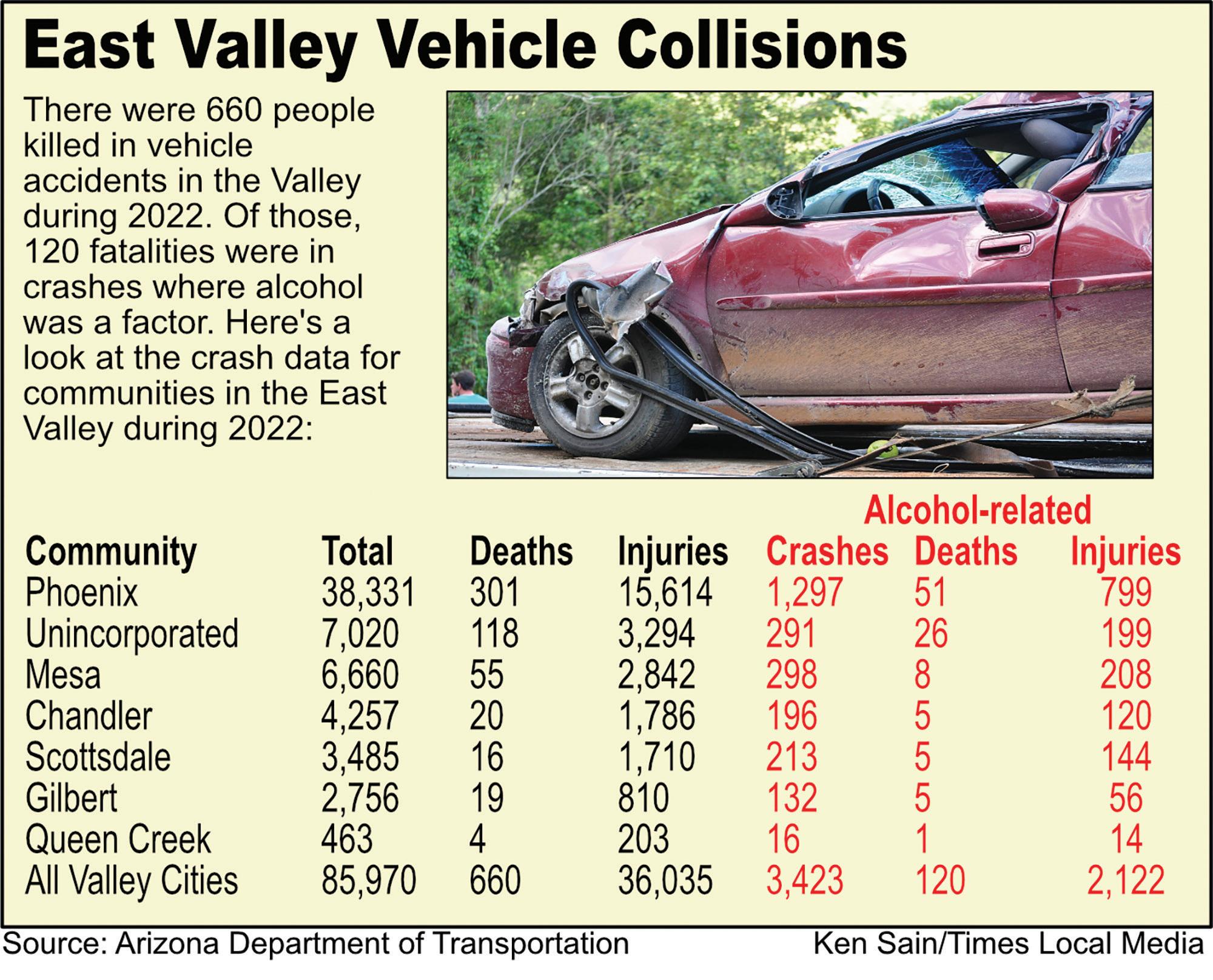
Five of the communities saw an increase in alcohol-related crashes and while Phoenix saw a 10% drop to 1,297, it saw an increase of people killed in these sorts of crashes.
Booze-fueled crashes claimed 51 lives in Phoenix compared with 49 in 2021, according to the report.
Among DUI-related crashes, Chandler and Gilbert similarly each saw five deaths compared with three the year prior; Scottsdale, five deaths, up from one and Queen Creek, one death compared with none in 2021.
Mesa, however, saw its alcohol-related crash deaths dropped to eight from the 11 reported in 2021.
Overall, alcohol-related crashes resulting in fatalities – 223 – saw a slight decline during 2022 in the state.
And when it comes to the number of injuries caused by drunken drivers, Chandler, Mesa and Queen Creek saw an uptick while Gilbert, Phoenix and Scottsdale saw a slight decrease.
Injuries in crashes related to alcohol decreased slightly for the state with 3,538 such crashes in 2022 compared with 3,617 in 2021.
The report also looked at pedestrian, bicyclist and motorcyclist deaths, which all went up last year. The data did not drill down to individual communities.
During 2022, there were 302 pedestrian deaths in the state, a 16.2% increase from 260 in 2021. For the same year 48 bicyclists died in crashes compared with 45 in 21, the report said, adding that bicycle-related fatalities have risen each year since 2018.
There also were 228 motorcyclist deaths in crashes, a 36.5% increase from 167 during 2021. The report stated that in 42% of the deaths in which authorities could determine helmet use involved riders and passengers who weren’t wearing helmets.
Although the total number crashes in Arizona for 2022 dropped 1.25% to
119,991 from 121,506 in 2021, the total fatality increased by 8.5% to 1,294 from 1,192.
Injuries from all crashes totaled 35,878 in 2022.
The report also said that the peak month for all crashes was generally in March and for fatal crashes the peak month was in October.
Also, the peak day for all crashes are Fridays and the peak day for fatal crashes, Saturday with the peak hour for fatal crashes occurring between 7-8 p.m.
Motorcycle crashes occurred more frequently between the hours of 4-5 p.m.; pedestrian involved crashes, 7-8 p.m. and bicycle crashes, 4-5 p.m. The peak hour for alcohol-related crashes was 2-3 a.m.
According to the report, children 14 and younger accounted for 42 fatalities and 2,789 injuries from vehicle crashes last year.
Also, vehicle crashes resulted in $21.3 billion in economic losses in Arizona.

Giving hope to Arizona's children and families battling childhood cancer.
Make a difference today by considering a donation to Children's Cancer Network.
As


To learn more please visit: www.childrenscancernetwork.org or contact: pluttrell@childrenscancernetwork.org



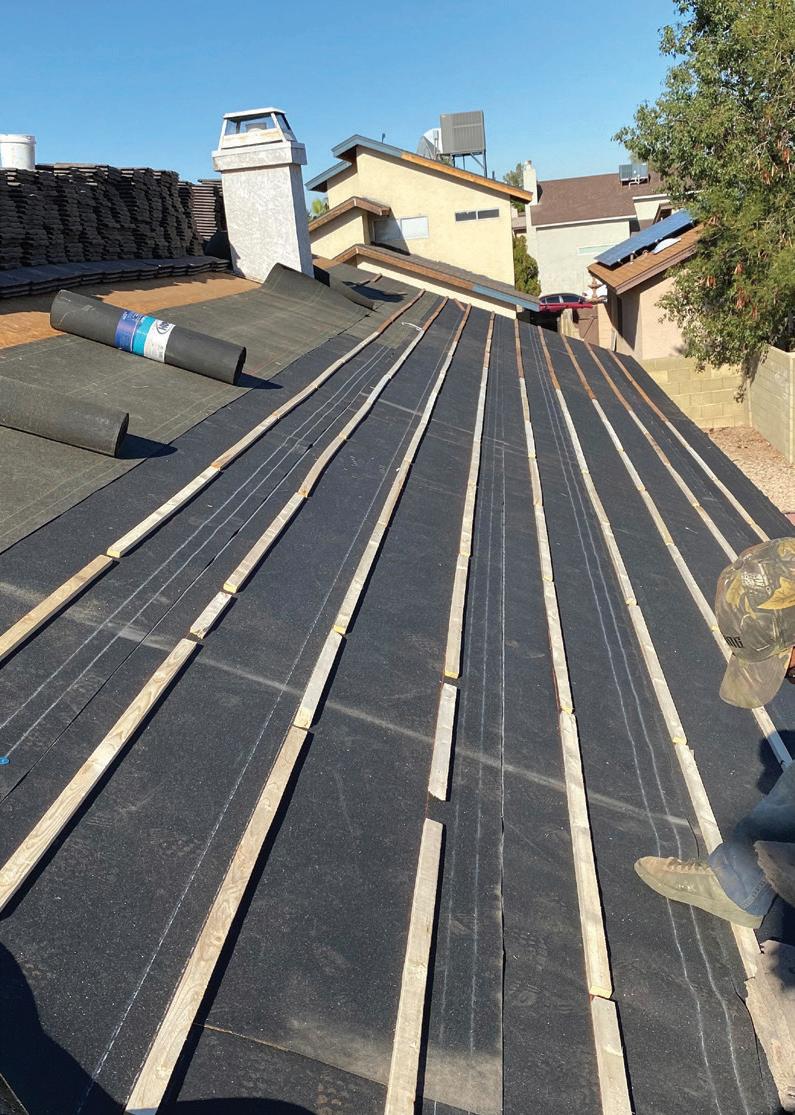
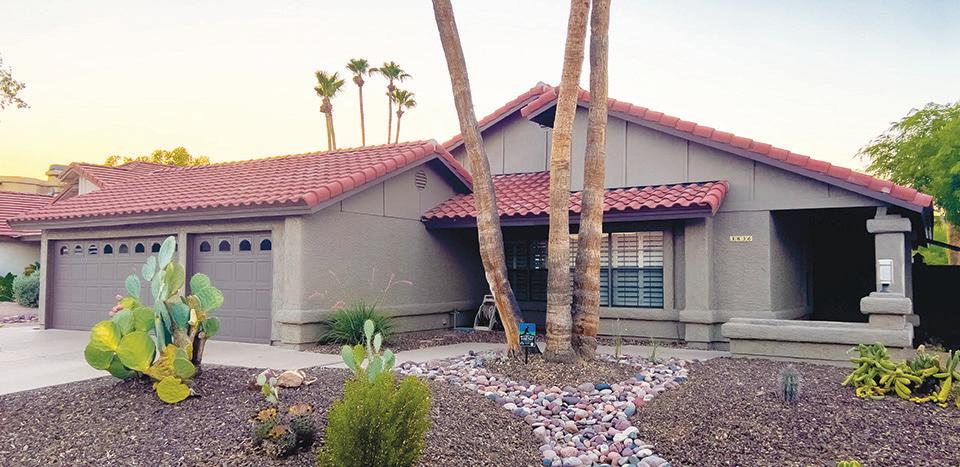




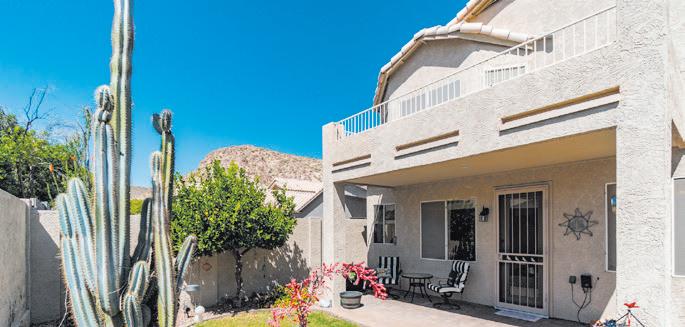






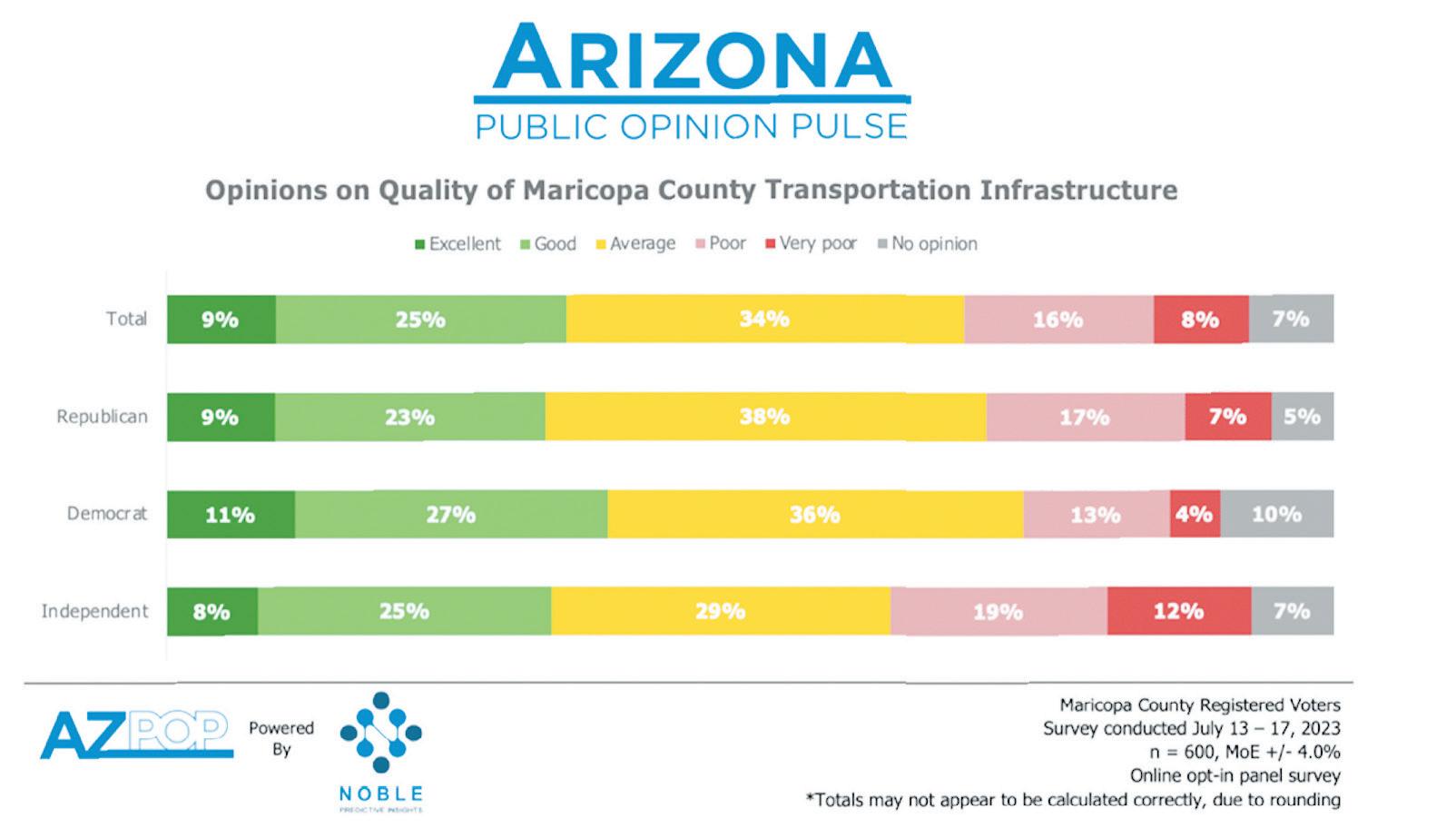
Maricopa County voters have mixed feelings about the Valley’s transportation infrastructure. (Noble Predictive Insights)
TAX from page 12
$20 billion the tax will raise over 20 years and bars MAG from using any of that cash to extend the light rail system.
Scot Mussi, president and executive director of the Arizona Free Enterprise Club, said that was still a “setback.’’
Mussi and his organization contend that, even with the changes, it still allows “radical plans like road diets,’’ essentially changes in street construction or layout to slow traffic –and from the perspective of foes, program designed to force people out of their personal vehicles.
But the big issue has been how much goes to projects other than new or improved roads, what Mussi called “failed transit projects that seemingly only enrich consultants and special interests.’’
A poll by OH Predictive Insights which said that 56% of those questioned support a renewed half-cent tax, with 17% opposed and 26% undecided.
servatives to have two votes, one for roads and one for mass transit.
Kolodin said he believes voters are willing to listen to arguments why this new plan is unacceptable.
“The messaging has to be we’re growing at a rapid pace, we’ve got to have our transportation funding dedicated to the roads that will allow us not to turn into L.A.,’’ he said. “We can’t have 40% of it siphoned off for public transit that services less than a percent of the population.’’
And Kolodin said if voters reject this plan, it will send a message to lawmakers to approve a different formula.
But not all Republicans agree – Senate President Warren Petersen, R-Gilbert, issued a press release calling what lawmakers approved the “most conservative Prop 400 plan in Arizona history.’’
He cited the elimination of funding from the levy for light rail expansion and the 63% earmarked for roads and freeways.





Pollster Mike Noble said even among Republicans there was a plurality, with 47% in favor and 30% against.
And in a separate question, Noble said he found that 54% believe the current light rail system should be expanded, with only 6% saying there should be no light rail.
Rep. Alexander Kolodin, R-Scottsdale, who voted against allowing this plan to go to voters, sniffed at the results.
And Petersen said it also ties the hands of the Maricopa Association of Governments, the agency made up of local community leaders that decides and funds the projects.
“No longer can dollars be shifted unilaterally after taxpayers have approved the measure,’’ he said.


“And the reason I doubt the accuracy of the polling is, if it were true that spending (nearly) 40% of this new tax on public transportation funding was something the voters wanted, nobody would ever have fought bifurcation,’’ he said.
That refers to the failed effort by con-
For decades the city and surrounding communities poured billions into building more and more freeways based on the belief that would ease congestion.
That didn’t happen. And it is only more recently that the area has invested in rail and other mass transit.
But Kolodin said that funding hasn’t helped.























Mesa, AZ - When it comes to chronic pain and/ or neuropathy, the most common doctor-prescribed treatment is drugs like Gabapentin, Lyrica, Cymbalta, and Neurontin. The problem with anti-depressants or anti-seizure medications like these is that they offer purely symptomatic relief, as opposed to targeting and treating the root of the problem. Worse, these drugs often trigger an onset of uncomfortable, painful, and sometimes harmful side effects.
The only way to effectively treat chronic pain and/or peripheral neuropathy is by targeting the source, which is the result of nerve damage owing to inadequate blood flow to the nerves in the hands and feet. This often causes weakness and numbness.

As displayed in figure 1 above, the nerves are surrounded by diseased, withered blood vessels. A lack of sufficient nutrients means the nerves cannot survive, and thus, slowly die. This leads to those painful and frustrating consequences we were talking about earlier, like weakness, numbness, tingling, balance issues, and perhaps even a burning sensation.
The drugs your doctor might prescribe will temporarily conceal the problems, putting a “BandAid” over a situation that will only continue to deteriorate without further action.
Thankfully, Mesa is the birthplace of a brand new facility that sheds light on this pressing problem of peripheral neuropathy and chronic pain. The company is trailblazing the medical industry by replacing outdated drugs and symptomatic reprieves with an advanced machine that targets the root of the problem at hand.

Effective neuropathy treatment relies on the following three factors:
1. Finding the underlying cause
2. Determining the extent of the nerve damage
(above 95% nerve loss is rarely treatable)
3. The amount of treatment required for the patient’s unique condition
Aspen Medical in Mesa, AZ uses a state-ofthe-art electric cell signaling systems worth $100,000.00. This ground-breaking treatment is engineered to achieve the following, accompanied by advanced diagnostics and a basic skin biopsy to accurately analyze results:
1. Increases blood flow
2. Stimulates and strengthens small fiber nerves
3. Improves brain-based pain
The treatment works by delivering energy to the affected area(s) at varying wavelengths, from low- to middle-frequency signals, while also using Amplitude Modulated (AM) and Frequency Modulated (FM) signaling.
It’s completely painless!
THE GREAT NEWS IS THAT THIS TREATMENT IS COVERED BY MEDICARE, MEDICAID, AND MOST INSURANCES!!
Depending on your coverage, your peripheral neuropathy treatment could cost almost nothing – or be absolutely free.
The number of treatments required varies from patient to patient, and can only be determined following an in-depth neurological and vascular examination. As long as you have less them 95% nerve damage, there is hope!
Aspen Medical begins by analyzing the extent of the nerve damage – a complimentary service for your friends and family. Each exam comprises a detailed sensory evaluation, extensive peripheral vascular testing, and comprehensive analysis of neuropathy findings.
Aspen Medical will be offering this free chronic pain and neuropathy severity evaluation will be available until August 31st, 2023. Call (480) 274-3157 to make an appointment.
Due to our very busy office schedule, we are limiting this offer to the first 10 callers. YOU DO NOT HAVE TO SUFFER ANOTHER MINUTE, CALL (480) 274-3157...NOW!!
We are extremely busy, so we are unavailable, please leave a voice message and we will get back to you as soon as possible.
Arizona lawmakers and the governor are giving up trying to force motorists away from carbon fuels by limits on gas-powered vehicles.
As part of a deal to try extending the Maricopa County road tax by putting on the ballot next year for a 20-year renewal, House Speaker Ben Toma and Democratic Gov. Katie Hobbs agreed to forever preclude the state from restricting the use or sale of a vehicle “based on the vehicle’s energy source.’’
The language also blocks local governments from imposing their own standards.
The net effect would be to bar Arizona from enacting legislation like California’s – which requires all new vehicles sold past 2034 to have zero-emission vehicles. That includes battery electric vehicle, plug-in hybrid electric vehicles and fuel cell electric vehicles.
Gov. West Moore of Maryland earlier this year announced an identical regulation for his state. And similar plans are being considered in Massachusetts, New Jersey, New York, Oregon and Washington.
Gubernatorial press aide Christian Slater would not comment.
But Toma defended the restriction and tucking that new statewide restrictions into legislation that is billed about allowing Maricopa County voters decide whether to extend a half-cent sales tax for transit.
“At this point, we felt that was legitimate,’’ the Peoria Republican told Capitol Media Services.
“Quite frankly, with all this talk about banning combustion engines or limiting combustion engines we are seeing in some of these other states, we felt that was the wrong policy for Arizona,’’ Toma said. “It was part of the negotiation. It’s in the bill.’’
a lot more options than more than a decade ago when the only realistic option was Tesla.
“If people want to buy electric vehicles for all the reasons they think they’re better, by all means, let them do that,’’ Toma continued. “But we shouldn’t be banning the free market or limiting the free market in any way.’’
Senate President Warren Petersen shares that viewpoint.
“Whether to drive an electric vehicle is a decision that should be made by our citizens, not the government,’’ said the Gilbert Republican.
House Minority Leader Lupe Contreras said members of his party had little choice but to agree to go along.
He said Democrats had higher priority issues in terms of what they wanted to ensure what was included in the Maricopa County tax legislation.
That specifically included ensuring that there are sufficient dollars in the plan to fund not just the highways but also mass transit which will get 37% of the estimated $20 billion raised over the levy’s 20-year life.
“We had to get as many things as we could get that were positive for the majority of Arizona,’’ he said.
And then there is the political reality.
“We’re in the minority,’’ said the Avondale Democrat. And he said things could be changed in the future if Democrats would take control of both the House and Senate, something that hasn’t occurred since the 1960s.
But what has happened in other states has not necessarily required legislative approval. Instead, these plans are being advanced by governors through executive action with support from local environmental regulators.
More to the point, he said that Republicans think that deciding what people can drive is not the role of the state.
“We believe in the free market,’’ Toma said.
“Ultimately, people can buy electric vehicles,’’ he said, noting that there are
That is what happened in California where that state’s Air Resources Board adopted rules last year requiring 35% of new 2026 cars sold in the state be zeroemissions, increasing to 68% in 2030 until reaching that 100% in 2035.
Sierra Club lobbyist Sandy Bahr called the provision in the Arizona outrageous,
see AIR page 25


AX550 Moving Glass Walls are an innovative solution that blur the line between where your indoor space ends, and outdoor living begins. Aspirational yet realistic, these sliding walls provide an elegant transition for indoor outdoor living that will help you create the home you’ve always wanted. AX550 Moving Glass Walls feature a narrow frame profile that in reases the amount of natural light flooding into your spa e. With panels as high as ten feet and as wide as five feet (varies by operating style), you can create an expansive entrance that not only makes a statement, but also opens and closes with ease.
Available from Lasting Impressions: Stop by our design showroom to see the latest trends!
4454. E. Thomas Road, Phoenix, AZ 85018 | 602.508.0800 | liwindow.com
Showroom Hours: Mon - Thu 8:30-5:00 | Fri 8:30-4:00 | Sat 9:00-2:00 | ROC#179513

Saying her powers are limited, Gov. Katie Hobbs said she is reviewing whether changes in state law could give her the authority to decide who can lease state lands and what activities can take place there.
In a wide-ranging post-session interview with the governor last week, she acknowledged that statutes generally require that state trust lands be managed to obtain their “highest and best use’’ and maximize their return to the state and the beneficiaries of the trust, mainly public education.
It was that requirement that resulted in Fondomonte being able to lease more than 6,000 acres of land and pump the water beneath it to grow alfalfa in western Arizona to feed dairy cows in Saudi Arabia, which bans such farming in its own country because of its water use.
The lease has generated nationwide publicity and calls on state officials to cancel it.
Hobbs said the issue isn’t that simple or that discrete.
“Fondomonte is where all the eyes are,’’ Hobbs told Capitol Media Services.
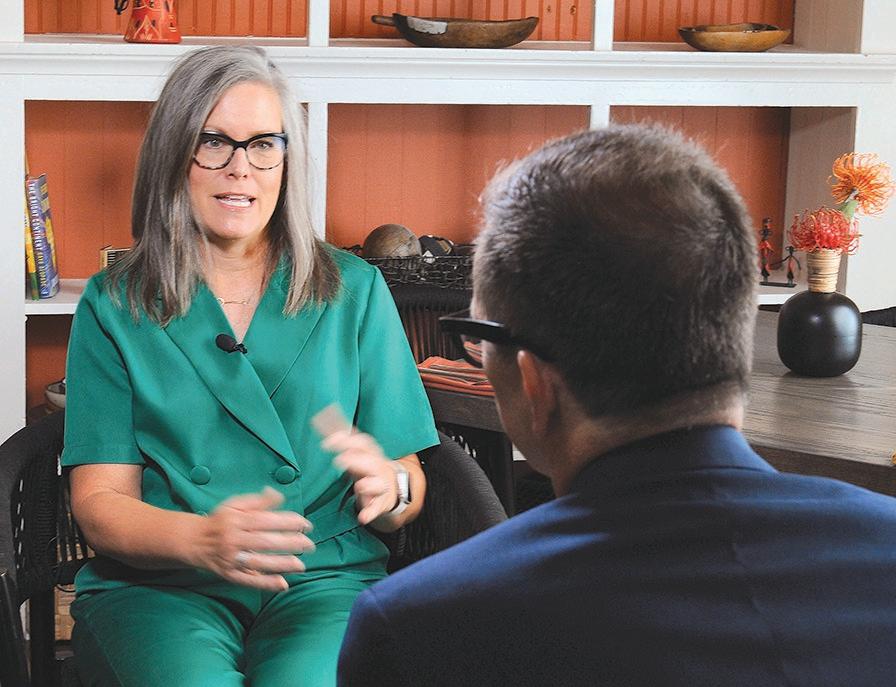
But she noted the company is not the only one growing crops on state land.
“It would be treating one leaseholder differently than others,’’ Hobbs said.
And then there’s a separate question.
Can the state refuse to lease land for growing alfalfa for export when it also is leasing land for other crops like vegetables which are shipped out of Arizona and, sometimes, out of the country.
“That’s a really valid question,’’ the governor said. “We can’t just unilaterally yank one lease because we don’t like that alfalfa’s going to Saudi Arabia.’’
What the state was able to do in April is revoke a pair of well-drilling permits it issued last year.
But that was based on a technicality that the company’s approval to make improvements on state land had expired. And that does not bar Fondomonte from continuing to pump water with the wells it already has.
None of this deals with the related issue that some of this farming, including Fondomonte, is done on private land where gaps in state laws limit the ability to restrict how much groundwater owners can pump.
All that, Hobbs said, makes the questions raised even more complex.
“If you look at curtailing farming in the Yuma region, that’s a huge food security issue for Arizonans and for a lot of Americans especially during the winter months,’’ she said, with estimates that the area produces 90% of the nation’s leafy green vegetables during the winter.
see HOBBS page 22
Gov. Katie Hobbs is promising to sign legislation to legalize the practice of people selling homecooked foods on the street when the Legislature reconvenes next year.
The fight over the Republican-driven measure escalated early this year when Ahwatukee state Rep. Patty Contreras tried to inject a requirement for kitchen inspections prior to getting a permit – a request GOP leaders oppose.
During the debate on the measure in April, Contreras – who has more than 15 years as a food service manager – rattled off the diseases people can get if food is not cooked at the proper temperature for the necessary time.
The governor, who vetoed a measure
that did not contain Contreras’ request, can’t – or won’t – say what she wants in a new version when lawmakers reconvene in January to gain her signature.
But about the only thing to which she will commit is that she won’t demand that health inspectors be allowed to drop in, unannounced, into home kitchens.
The question of other inspections, however, remains unanswered.
At issue is not just the sale of tamales that became the hot-button issue that became the focus of the extensive debate earlier this year. It also comes down to what the governor believes is the role of government in regulation.
More to the point, it focuses on the question of whether Arizonans, given certain information, should have the right to assume certain risks without
having the state tell them they can’t.
In an interview last week with Capitol Media Services, Hobbs sidestepped questions of exactly where that line should be, saying “it depends on the issue.’’ And the governor said she would not answer questions about “a bunch of hypotheticals.’’
But Hobbs has had a record on the issue – and not just with her veto – of what was dubbed the “tamale’’ bill.
As a legislator, she was one of just six state senators who opposed what was known as “right to try’’ legislation, permitting terminally ill patients to get drugs that have not yet been approved by federal agencies.
And she wasn’t in the minority just there.
That plan went to voters in 2014. And it
was approved by a margin of more than 3 to 1.
Now the issue is whether Hobbs is willing to legalize the common practice of some families of making tamales and similar items at home and selling them on the street.
The governor vetoed HB 2509 in April despite its overwhelming bipartisan support, saying that allowing cooked foods to be prepared by individuals and sold to the public would “significantly increase the risk of food-borne illness’’ by allowing “cottage food vendors’’ to sell “high-risk foods.’’
What particularly frosted a number of Democrat lawmakers who voted for the bill was being blindsided by the gover-
see TAMALES page 23


HOBBS from page 20
Still, the governor acknowledged, even alfalfa could be considered part of that “food security.’’
“We grow a lot of cattle here,’’ she said.
A related question is whether there is sufficient water for population growth.
That is addressed somewhat in urban “active management areas’’ where developers need to show access to a 100-year assured supply of water. And the state is not issuing building permits in some areas of Maricopa County which cannot meet that goal.
Rural areas, however, generally are unregulated. The governor said there is no simple and uniform fix.
Hobbs also said she is weighing whether to declare a state of emergency due to the unusual heat.
The governor said such a declaration, like one that might be issued after a fire or flood, would free up state dollars that could be used for everything from cooling centers to helping some people pay their utility bills.
All this comes after Hobbs demanded that the state’s utilities provide her with information about how they are prepared to deal with what has been unprecedented warm weather, particularly in the metro Phoenix area.
That has included not just a streak of high temperatures exceeding 110 degrees but a series of nights where the mercury has not dropped below 90.
“We just want to make sure that the utilities are focused on not turning off air conditioning when people can’t pay right now that could result in people dying,’’ she said. “There was a really high-profile death a few years ago.’’
That refers to Stephanie Pulliam, a Sun City West resident who died of heat-related complications after Arizona Public Service Co. cut off her power on a 107-degree day after someone paid only $125 of her $176 bill. The company eventually agreed to an out-of-court settlement with the family.
Much of what the utilities told the governor already was a matter of record, as most have to comply with the rules set down by the Arizona Corporation Commission.
The rules require companies to ei -
ther stop disconnections from June 1 to Oct. 15 each year or when outside temperatures exceed 95 degrees.
And even Salt River Project, which is not subject to commission regulation, agreed not to shut off power when the National Weather Service has issued an excessive heat warning.
The governor also waded into a multi-year battle over a 2016 law that stripped cities of their ability to regulate vacation rentals. Hobbs said she wants lawmakers to revisit the issue.
The measure was sold to lawmakers as allowing individuals to rent out a spare room to make a bit of extra cash. In fact, that’s how Airbnb got its name, the idea being an air mattress set up for a guest.
But the reality turned out to be something quite different.
In some communities, homes and apartments in entire areas have been bought up by investors to be converted into these short-term rentals, drying up the availability of housing for local residents.
Facing a barrage of complaints, lawmakers have previously agreed to let cities have some power to require owners to register and give control over things like noise violations.
But efforts to go further – like limiting the number of short-term rentals in any neighborhood – have fallen flat.
“If you go across the state, there’s different issues, that short-term rentals affect different communities in different ways,’’ the governor said. “I think that cities should be able to regulate them in the way that best works for them.’’
And that, she said, means rolling back state-imposed restrictions.
What that can mean, the governor said, is allowing some limits where appropriate. And Exhibit No. 1, for her, is Sedona where estimates are that close to one out of every six housing units is a short-term rental, far higher than any other Arizona community.
“It’s affecting the ability for workforce housing,’’ Hobbs said.
“It’s a tourism economy,’’ she continued. “And a lot of people that work in that economy can’t live there.’’
But should communities be able to outlaw them entirely?
“I don’t have an answer for that,’’ the governor responded.
It didn’t help the situation when the governor said that it would open the door to items being cooked in home kitchens with “rodent and infestation.’’
“That is offensive,’’ said Rep. Alma Hernandez, D-Tucson, who voted for the bill. “And I would be glad to put up my nana’s kitchen or my mom’s kitchen up against anyone’s kitchen.’’
Hobbs conceded that was one of the stumbles of her first session.
“We’re in the process of building our legislative team,’’ she said, the staffers who are supposed to work with lawmakers.
“We need to have more focus on the ground there,’’ Hobbs said. “And we’re going to do that next time.’’
In the end, enough House Democrats agreed to change their original votes in favor of the bill and uphold her veto, preventing her the embarrassment of being the first governor since 1981 of having her action overridden.
Hernandez said she has been assured by the governor she would sign such a law with some yet-to-be specified
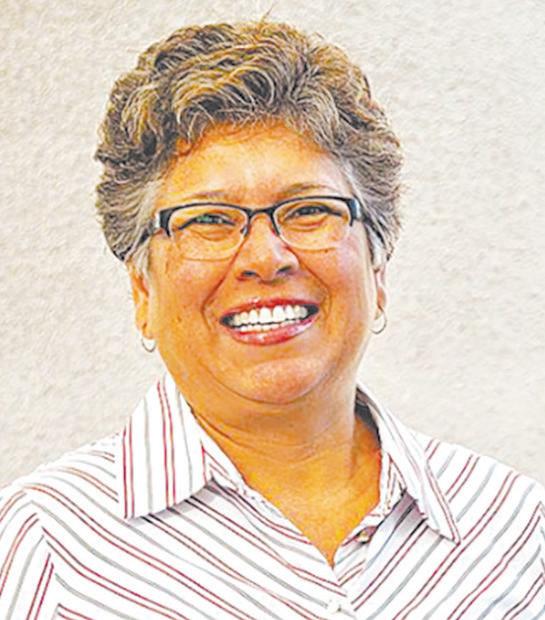
Democratic state Rep. Patty Contreras, an Ahwatukee resident, who has more than 15 years as a food service manager, tried unsuccessfully to require the health department to inspect home kitchens but Republicans balked at her move. (File photo)
changes.
There already were various safeguards in HB 2509.
The legislation would not have allowed just anyone to start selling tamales legally out of their homes. Ditto menudo, posole, pupusas or anything else not pretty

much readily available.
First, it restricted what ingredients could be used. So, for example, no shellfish.
Producers would need to register with the health department and take a stateapproved course in food handling.
Anything with meat or dairy would have to be delivered in person. And no item could be transported more than twice, with a total limit of two hours.
Perhaps most significant were disclosure provisions on the label, including the producer’s name and state registration number and a statement that said “this produce was produced in a home kitchen that may process common food allergens and is not subject to public health inspection.”
So with all that information, what is the problem with letting people decide whether to purchase these items versus the government saying that you can’t?
“I think it depends on the issue,’’ Hobbs said.
Hernandez, for her part, does not see it as a difficult question.
“At the end of the day, I believe that if you’re buying these products by your
own will you know what you are purchasing,’’ she said, pointing out the requirements for not just registration but also disclosure that these are homemade items. And Hernandez said it isn’t the role of government to overrule that option.
“I think that is a personal decision that I think individuals can make and should be able to make in their own,’’ she said, saying what was approved was sufficient.
So what more does Hobbs want?
She’s providing no specifics other than seeking to ensure the health department has the resources “to take on this new sort of regulation.’’ And about the only thing Hobbs has said she isn’t demanding are unannounced inspections.
But having health inspectors check out the premises before production can start?
No answer.
There is some support for that.
Contreras wanted things like examining the area to ensure it is free from indication of pests and debris, that cooking supplies are clean and stored in sani-











Bosco’s group of loyal and enthusiastic parents and alumni raised at their annual gala last year.
And for the first time, many of the students will see something that only a dwindling number of Catholic school students across the country ever see: three nuns in traditional habits.
Three Sisters from the Most Holy Rosary of the Philippines have arrived at adjacent St. Benedict’s Catholic Church, though only one will be fulltime at the school, teaching fifth grade.
Besides Sister Murphy, Sister Ruth will be working at St. Benedict’s on various faith-related programs while the newest arrival, Sister Delia, will toggle between the school and the church.
When Sister Delia is at St. John Bosco, she will be speaking with students about the Catholic faith.
Bescak is thrilled with the presence of nuns – once a mainstay of Catholic elementary school faculties – and said "I know for a fact many of the little ones have never seen one" in a habit.
“It's a very special experience that our students get to have. Our teachers are all trained and they teach religion,” she said. “But the bonus of having another sister come out is she can add more to it and she’ll be able to go in to every classroom all grade levels at least once a month and do a lesson and answer questions and meet with the students. And we’re very, very excited about that.”
Bescak, who attended Catholic schools growing up in Ohio and has 16 years of teaching experience in both public and parochial schools, is starting her ninth year at St. John Bosco and her third year as principal.
As excited as she is about the nuns, Bescak is even more excited about the 22-year-old school’s consistent growth since 2021, when enrollment was at 366 students.
That growth not only mirrors but may even exceed the increase in Catholic school enrollment nationwide.
“In the 2022-2023 school year, Catholic school enrollment has grown 0.3% to 1,693,493 students in 5,920 schools, continuing the two-year trend of increasing Catholic school enrollment across the nation,” according to a data briefing published last year by the National Catholic Educational Association.
“Catholic schools have attracted and
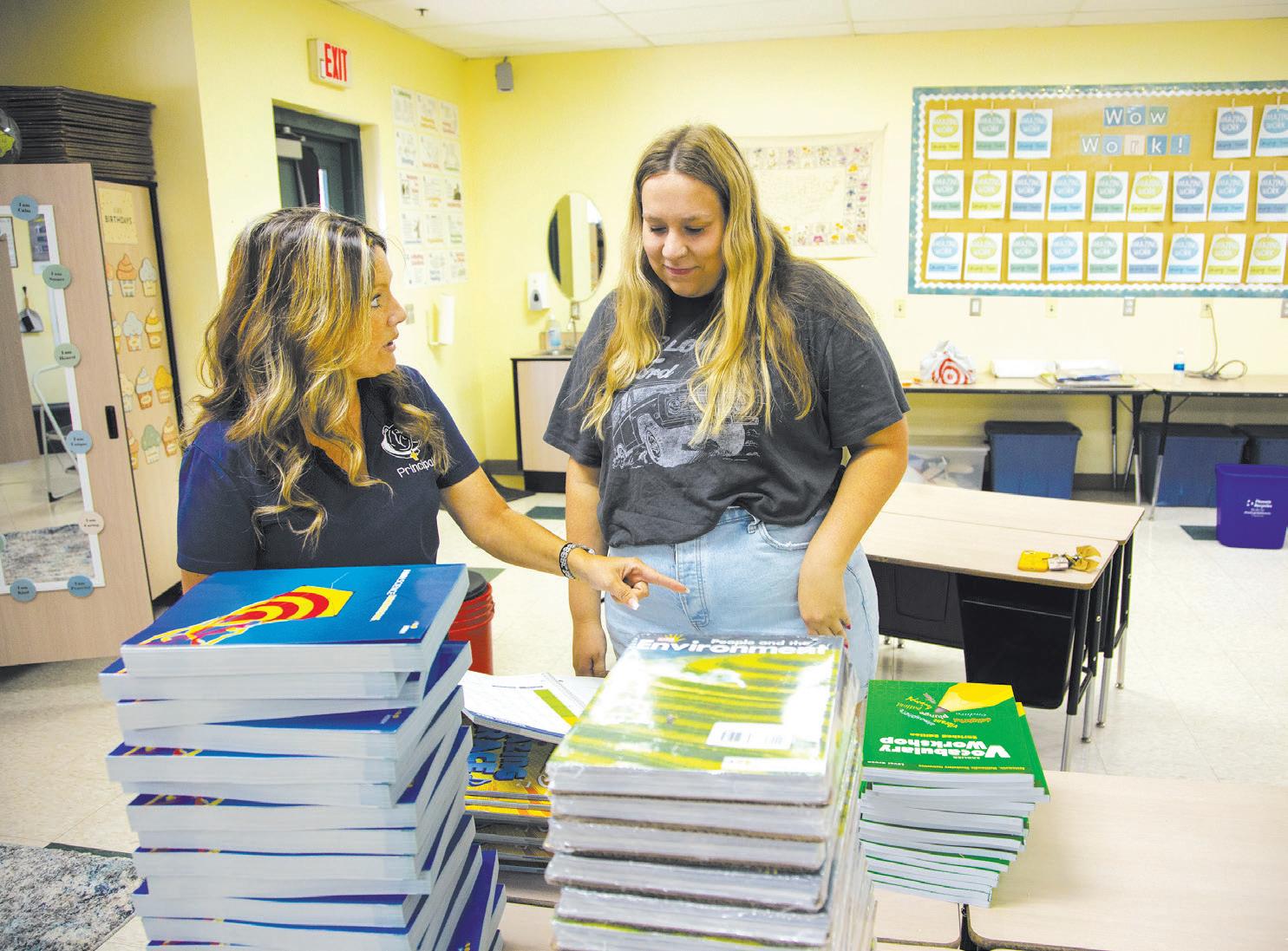
retained new students, supporting their academic, spiritual and mental health,” it added.
The Catholic News Agency in February reported “two straight years of notable growth” in enrollment in the two years prior to last school year.
Its added total national enrollment in Catholic schools is still below pre-pandemic levels – just as it is in most Arizona public school districts.
Arizona’s expansion of school vouchers for private schools has helped fuel St. John Bosco’s enrollment, although Bescak believes other factors are also exerting a significant impact.
“Our retention rate is at an all-time high and then the new students coming in are actually from all over and not just Ahwatukee and Chandler,” said Bescak, a Gilbert resident whose daughter will be part of the school’s largest graduating class ever next spring with 42 eighth graders receiving diplomas. Many of those grads, like those before them, will be headed to Catholic high schools.
Bescak said that while enrollment growth may be resulting partly from her team’s modest marketing effort that includes presentations by a small cadre of student ambassadors, word of mouth may be playing a bigger role.
“They speak and we pass out flyers and stuff about the school, but other than that I truly believe it’s word of mouth,”
proved strategic plan sets 520 students as its maximum enrollment. The school has 22 classrooms, a state-of-the-art media room, music room, library, science lab, and multiple sports fields.
That total is driven by a determination to keep class sizes small. From first through eighth grade, each level has 50 students divided between two classrooms. The 3-year-old pre-school program can accommodate a total of 30 kids also divided between two classrooms.
“We could put more in the classroom but I want to stick by what I told parents,” Bescak said. “They do want the smaller class size.”
Still, Bescak noted “we need to also plan for the future" because of St. John Bosco’s continuing growth.
she said, adding “We haven’t done much different with our marketing plan" over the last five years.
Citing the high pupil-retention rate, she said the school’s most enthusiastic endorsements come from parents, who talk to people – even inviting other parents to dinner. “One of our school board members decided one night to walk over to a family and buy them dinner because he just thought they were so sweet,” Bescak recalled.
“They got to talking and his kids were there with their Bosco uniforms on and the family struck up a conversation and now that family is coming to my school.”
“I’ve been giving tours almost every day over the summer,” said Bescak, adding that she stopped giving tours for a few weeks to prepare for the new school year.
She said that when she or her preschool director, Kristina Bileski, give tours, “we both found out this summer that when we ask parents, a lot of them are saying they want a quality private Catholic education.
“From what I am hearing, they want to have a little more security per se. There’s a lot going on in the world and they want the traditional curriculum that Catholic schools give. They want faith and spirituality. They want to keep their kids young a little longer, more innocent longer.”
Bescak said the school’s recently ap-
That decision ultimately will not only involve the diocese and parish but also the school’s board, which includes Marianne Biegler, president; Cindy Casaus, vice president; and members Laura Underwood, Marc Rivas, Erica Seidel, Chad Stallings, Moti Salloum, and Brian Wiscombe.
Bescak is in the process of renting a portable office unit and hopes eventually to see an addition to the school that would add a couple classrooms.
“Then the families have been asking forever for an indoor gym. I don’t know when that indoor gym is going to happen but it’s definitely going to be on the list of ‘how can we make that happen?’”
“We are growing and if we can continue to grow, I want to make sure that we have utilized our space to the maximum potential,” she said.
Then too, among shorter-range goals, Bescak is eagerly awaiting the completion of St. Benedict’s massive interior and exterior renovations that are converting the building into a facility that actually looks inside and out like a church and not a giant meeting hall with an altar and pews.
Though she doesn’t know exactly when the project will be done, she expects it to be completed before Graduation Day 2024.
“I’m planning on my daughter’s class graduating from that church,” she said. “We’re planning on this eighth grade class being the first class to graduate from it.
“It’ll be done this year,” Bescak said, adding jokingly, “One way or the other, it better be done.”
AIR from page 18
especially now with what she said is the evidence that the extreme weather conditions are due to climate change which, in turn, is being driven in part by tailpipe emissions.
“And yet every step of the way they either don’t act or, in this case, take action that actually gets in the way,’’ she said.
“It’s insane, it’s wrong,’’ Bahr continued. “And I don’t know why in the world the governor’s office or proponents relative to action on climate would agree to that kind of thing.’’
Toma brushed aside questions of whether the state should be doing more
PLANNING from page 10
up ambiguity over whether the ADU provision or a homeowners association would prevail when someone wants to build a casita in their backyard.
When that question came up before the Ahwatukee VPC, some panel members said HOA rules always trump city code; city staff appeared to not know the answer.
That ambiguity was never clarified during the Planning Commission meet-

to deal with climate change and the effect it is having on residents and businesses,
“This is about transportation, fundamentally,’’ he said of the legislation. “This is not a debate about climate change.’’
But the speaker also questioned the effects of vehicle and other emissions.
“Historically, throughout the history of the planet, climate has changed,’’ Toma said. “So there’s that talking point.’’
Bahr said the ultimate answer for those who want to restrict the sale of gasoline and diesel-powered vehicle may have to come from Washington.
Earlier this year, the Biden adminis-
ing last week either.
To a large extent, city staff told the Planning Commission that any problems would be resolved during the site review process when a homeowner sought approval for his or her ADU.
Staff also dismissed demands by some that additional parking should be required at a single-family home site with an ADU because otherwise casita tenants would be parking in front of neighbors’ homes.
“Our thought is that parking has been



tration proposed new greenhouse gas emission standards that would advance the sale of electric cars and trucks.
Unlike California, standards to be set by the Environmental Protection Agency would not spell out a specific goal for the percentage of zero-emission vehicles sold. Instead, each manufacturer would have to comply with overall emission standards, a move that should force them to produce – and get consumers to buy –sufficient electric vehicles to comply.
EPA officials estimated that it would require between 54% and 60% of sales of vehicles in 2030 be zero-emission ve-
provided with already existing driveways for the ADU,” a city staffer told the Commission.
“Currently, every single-family home has to have two required parking spaces…So if you have a two-car garage and we have a 20-foot (driveway) you actually have roughly four spaces there tandem.”
He added that similar concerns had been raised in Tucson when that city created an ADU addition to its Zoning Code and that “people couldn’t figure
hicles, rising to about two thirds in 2032.
“We have reestablished the United States as a leader in the clean transportation future,’’ said Ali Zaidi, deputy national climate advisor to President Joe Biden, in announcing the plan. “This is a moment of transformation.’’
Bahr said the provision blocking state action on vehicle sales essentially amounts to lawmakers defaulting to the federal government to make such decisions.
“There seems to be no interest at the Arizona State Legislature in taking any kind of control of our future when it comes to climate change,’’ she said.
out where to put” any required additional parking “so we have not proposed any additional parking requirements.”
Several Commission members praised city staff for the work it put into crafting both amendments.
“I was very impressed with both your knowledge of the entire code and your ability to make all these sections work,” one commission member told city staffers. “And overall, I think you guys have just done a fabulous job.”





















Chandler Police Chief Sean Duggan knew what he wanted to do early in his life and set out a plan that would eventually end with him working for the FBI.
That plan, like many set by young men and women, ran into some detours that eventually brought him to Chandler.
Duggan will be retiring at the end of this year, ending his run as the city’s top cop for nearly 10 years. He’s been a police officer for 37.
Following the plan laid out in Chandler’s charter, City Manager Joshua Wright will hire Duggan’s replacement. A national search has begun, but the city also intends to look at internal candidates.
Duggan said he knew at an early age he wanted to join law enforcement because his dad was an officer in New York before the family moved to Scottsdale when he was 14.
And he was in a hurry to get to that FBI job after graduating from Scottsdale High School in 1982.
“I started … right out of high school,” Duggan said. “I went straight to summer school at [Scottsdale Community College]. I just had this future time perspective, ‘I just gotta get done, I gotta get moving.’ In hindsight, it’s crazy.
“You don’t really smell the roses, but I graduated college in three years. I went to school every summer.”
Duggan said that when he graduated from Arizona State University in 1985, there were a few paths to get hired by the FBI. The first was to get a language degree, which he didn’t have. Another path was to study engineering, which he didn’t do.
“There’s another path, and that’s getting … the street experience,” Duggan said. He went to work for the Scottsdale Police Department, starting out on patrol just like his father did.
“I loved it,” Duggan said. “Every shift was different, you had no idea what was going to happen next. It could be mundane boredom, to just insanity, and sometimes terror.”
He rose fast through the ranks in Scottsdale, working special assignments after six years of patrols. That included a stint working on the SWAT team. He was promoted to
sergeant and then lieutenant. He was promoted to commander, in charge of about 112 square miles of northern Scottsdale.
“That’s the first taste, that’s where you’re cutting your teeth,” Duggan said. “If you want to be a chief, you’ll learn how as a precinct commander, because you are the chief of that precinct.”
After that came a five-year stint as assistant chief in Scottsdale.
That was the job he was working when Chandler had an opening for chief. Before applying, he did his homework.
He met with the school superintendent, the president of the Chandler Chamber of Commerce, business people and faith-based leaders.
“I didn’t want to go anywhere that was broken,” Duggan said. “I had a good job, and I worked in a really good community. So I wanted to make sure that [Chandler] had those same values and the community appreciated their police.
“My homework showed that. … I made the right decision.”
Duggan said he is proud of many of the accomplishments he and his team have made in the past decade. One is the low crime rate, which has been going down each year.
“Now, if you’re a victim of any one of those crimes, that measure doesn’t mean anything, understandably,” Duggan said.
“But just taken as a whole, when you look at the measure of crime in a city of almost 300,000 people, we are the envy of many communities.”
Duggan said he’s also proud of the team he will be leaving behind on Jan. 1. He called it a deep bench that he was able to identify, cultivate and mentor.
Another factor he’s proud of is the Chandler’s embrace of technology.
The city was one of the first in the nation to use body cams. They also were an early adopter of letting citizens text 9-1-1 and send videos through text to 9-1-1.
However, he said his team’s biggest accomplishment is the relationship they developed with the community.
“Overwhelmingly, people are proud of their police,” Duggan said. He said that shows up in bond elections and budget surveys and that officers encounter it daily on the streets.
That doesn’t mean there were not mo-
ments that relationship was tested. After the death of George Floyd in Minneapolis, one of the largest protests in Arizona was outside Chandler Police Department’s downtown office.
“We had those nine days of protests, and … very large protests where folks came to the station, right there, and demanded the police come out and talk to them,” Duggan said.
He said the fact they were peaceful and did not escalate was because of the existing relationship.
“We were well-positioned for that type of conflict.”
Duggan has become a national leader in policing, serving as an officer for the International Association of Chiefs of Police. He’s also served on numerous state bodies, including the Arizona Association of Chiefs of Police and the Arizona Criminal Justice Commission.
He even achieved his ambition, sort of, working for the FBI.
“I had the great privilege to work alongside the FBI in many capacities. I did a fellowship years ago, where I spent six months in D.C. as part of the Joint Terrorism Task Force. I’ve done a lot of work with the FBI. And I think if I would have been an agent, I wouldn’t have had those opportunities.”
And in 37 years of policing, he’s experienced sadness as well.
“We’ve had tragedies,” Duggan said. “We’ve lost five officers since I’ve been here, five in-the-line-of-duty deaths. Those, they shake the core of any department. So that’s something that’s on all of our minds always.
“In the 10 years I’ve been here we’ve had seven officers shot, and by miracle they have not died. We’ve had dozens, many dozens of officers shot at.”
“So the training, the technology, policing smarter and more effectively, we give them the tools to be successful, give them the tools to be safe.”
Duggan said he still has more to offer and once he is officially retired, he may do some consulting.
He said he has no interest in working 9 to 5 again, but staying involved as a consultant is an idea that excites him.
One of Duggan’s hobbies is hockey. Usually, because of his work schedule, the only time he can play is late at night.

Once he retires, he hopes to find out what it’s like to play hockey during the day.
“And I’ll look at other ways to continue to serve our community here in Chandler,” he said. “I’ve been doing this for 37 years, almost my entire adult life I’ve been serving, I’m not going to go from 100 miles to zero.”
Chandler Mayor Kevin Hartke said Duggan deserves a lot of the credit for the city’s low crime rate.
“I think his biggest legacy is setting up a system, and a police force, that is really responsible for our declining crime rate in Chandler,” Hartke said.
The mayor said that if the search goes past Jan. 1, he is confident that the city’s three assistant chiefs can lead the department until a new chief is selected.
“We’ve got a good … window, and underneath him, he has raised up three excellent assistant chiefs,” Hartke said. “I’m quite hopeful that we will replace him within this window, but if not, if we need a temporary chief … then we’ll be well positioned as well.”
What would Duggan tell his successor?
“We have an amazing department for the next chief coming here,” he said. “This department is not broken by any means, it’s a model agency. There are opportunities to grow. The team we have here is very well developed, and they’re eager, and ready.
“It’s a great department to inherit.”

TAMALES from page 23
tized cabinets, and that refrigerated food is properly stored and dated.
Th at went nowhere with opposition from Travis Grantham, sponsor of the measure. And the Gilbert Republican told Capitol Media Services his views have not changed.
“You’re going to get bureaucrats telling them their drain doesn’t drain fast enough and they need to spend $20,000 to have a bigger drain or they’re going to be put out of business,’’ he said.
“Th at’s a non-starter to me,’’ Grantham said. “And that’s exactly what the bureaucracy will do.’’
He said there are things that are appropriate.
“You can train them and require them to have a food handler’s certifi cate,’’ Grantham said, things that were in the vetoed measure. “But allowing state inspectors into people’s homes to inspect their kitchens and possibly cite them and be in their private residence, that is a problem’’
Arizona has a long history of letting people make their own choices without government interference.
The re’s laetrile, also known as amygdalin and vitamin B17.
Proponents argued that the cyanide in the drug which can be found in things like apricot pits supposedly kills cancer cells.
But it has been banned by the Food and Drug Administration. And Arizona law makes it illegal to manufacture, sell, or even give away a drug unless it has been approved by the federal government.
In 1970s, however state lawmakers approved an exception for laetrile, calling it a “nutritional supplement.’’
Sen. John Kavanagh, R-Fountain Hills, tried multiple times in the last decade to repeal that exemption.
But Kavanagh gained no traction as colleagues said people should be able to decide what is appropriate for themselves. And Nancy Barto, who chaired the Senate Health Committee, refused to even give the bill a hearing.
And then there’s that 2014 voter-approved measure – which Hobbs opposed but voters approved – allowing access to experimental drugs by those who are terminally ill, defined as “a disease that, without life-sustaining procedures, will result in death in the near future or a state of permanent unconsciousness from which recovery is unlikely.’’



www.ahwatukee.com

Ahwatukee Boy Scout Troop 14 will make history last Saturday when five members receive Scouting’s highest honor, the Eagle Award.
Rafael Mather Alvear, Collin Bridge, Garrett Giannantonio, Evan Fear and Luke Tafoya will Their Eagle Scout Court of Honor will be on August 12 at Esperanza Lutheran.
In over a century since a New York Boy Scout earned the nation’s first Eagle Award, over two million young men have achieved the honor, which requires a Scout to organize and execute a project that not only benefits the community but also tests their organizational and leadership skills.
The five new Ahwatukee Eagles contributed a combined total of over 600 volunteer hours to their projects.
Troop 14 formed in 1994 and has matriculated 97 Eagle Scouts.
The troop meets at Esperanza Luther-

an Church at 2601 E. Thunderhill Place, Ahwatukee, on select Wednesdays from 7-8:30 p.m.
People interested in learning more
can go to bsatroop14.us or email Scoutmaster Phil Mather at pgmather@ gmai.com or Michael Fortunato at michael.j.fortunato@intel.com.
Here’s a rundown on the new Troop 14 Eagle Scouts:
Rafael Mather Alvear
Rafael, a 15-year-old sophomore at Desert Vista High, said, “Originally, I wanted to do something either for heat mitigation, dogs, or the homeless as my Eagle Scout service project.”
He learned they were not mutually exclusive.
“As I learned more about the homeless, I discovered how dogs can be an integral support for people who are struggling to even get by,” he said. “The Human Services Campus, a 9-acre facility containing multiple services for the homeless, was the perfect organization to carry out the project.”
He planned, raised money and with fellow troop members built a dog park at Human Services campus. While the
It was a sad day in September 2022 for scores of impoverished Phoenix kids when the Camp Colley Foundation dissolved.
It announced it could no longer maintain its partnership with the city to run Camp Colley, a 30-acre outdoor adventure camp on the Mogollon Rim, about 50 miles north of Payson.
The camp is named after former Phoenix Parks and Recreation Director James A. Colley, whose vision was to provide structured, supervised outdoor nature education and experiences to underserved youth.
But all is not lost, as the city administration and Parks and Recreation Board are making efforts to reopen the camp next
year.
The Phoenix Parks and Recreation Department is seeking an operator for the camp, located 145 miles north near Happy Jack.
“Camp Colley not only has a meaningful core mission but is also a perfect getaway summer camp with the space and amenities for many different types of camping experiences,” the city said in an announcement.
The campgrounds include a dining hall, bath house, barn, equestrian area, remote camp site, solar panels, among numerous amenities.
The department is asking qualified proposers to submit a response to the Camp Colley Program Operations Request for
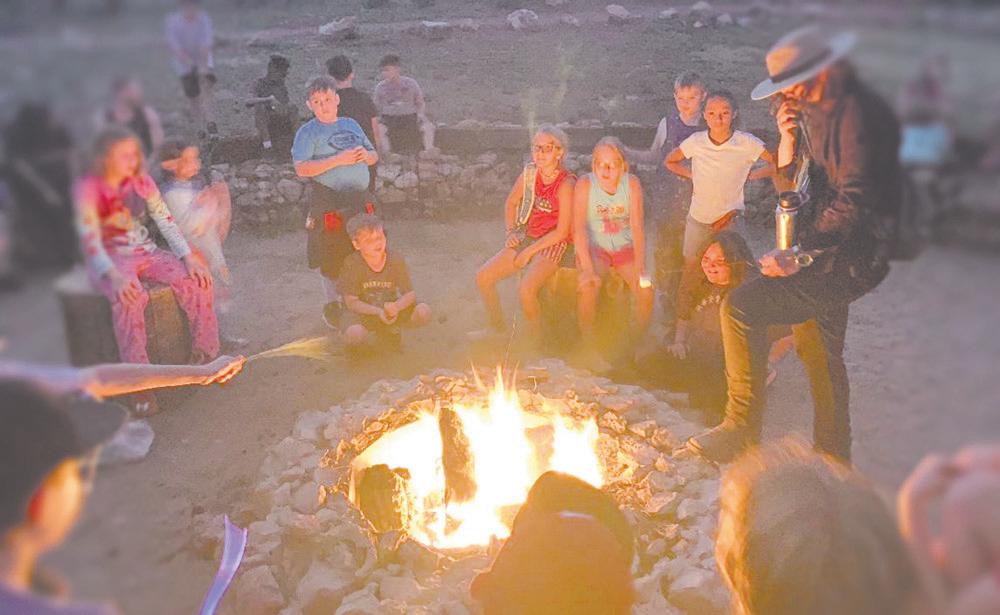
An Ahwatukee professor’s Project Humanities at Arizona State University has completed its virtual Podcast Club events and is now looking forward to a fall season that includes its Hacks for Humanities.
But this month, the award-winning program founded by Dr. Neal Lester, Foundation Professor of English at ASU, also has scheduled two of its Service Saturdays outreach efforts to homeless people in downtown Phoenix.
The biweekly outreach efforts are this Saturday, Aug. 12 and Aug. 26.
Project Humanities has had a busy summer, Lester said, that started with its second annual Research Ambassadors Showcase that completed its Research Ambassadors Program, which Lester said “provides an opportunity for undergraduate students to complete a research-based applied project that considers a social justice issue under the direction of a faculty mentor.”
Ambassadors shared their research
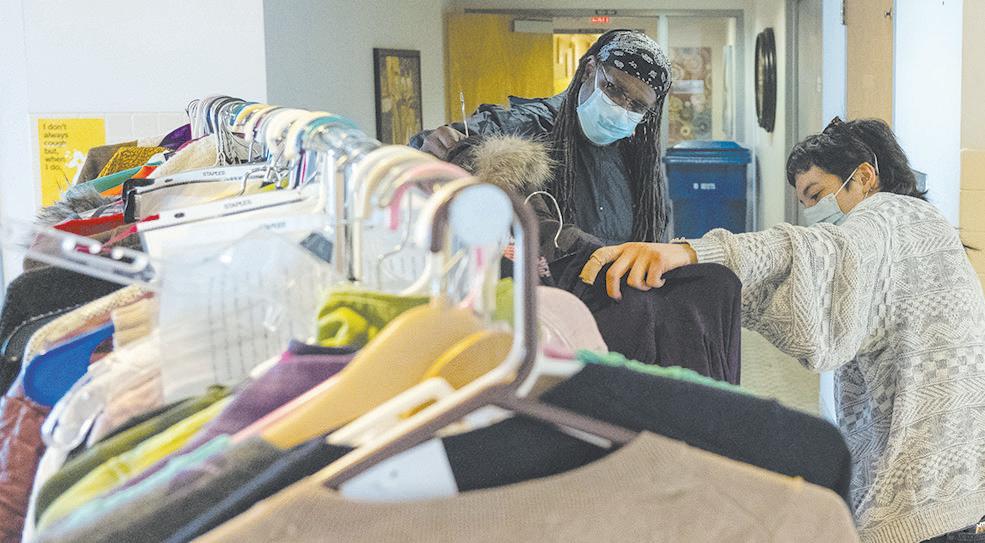
and findings for topics such as “Autism & Policing,” “ESL & Digital Literacy,” “Caregiver Advocacy” and “Title IX in Pac-12 Schools.”
Project Humanities’ ongoing homeless outreach in downtown Phoenix rou-
tinely serves over 200 adult clients experiencing housing insecurity.
Donations from Sigma Gamma Rho Sorority, Inc., Arizona Soap Company, and the Corona Del Sol National Honors Society have provided hundreds of water
bottles, 100 to 200 bars of soap, and almost 100 backpacks for clients.
Project Humanities has been serving this vulnerable population since 2011, aiding over 18,220 people since its inception.
Lester frames its mission as “to humanely assist unsheltered individuals in Phoenix through a year-round collaborative community service effort by providing clothes, shoes, and toiletries.”
“The object of this outreach is to aid those in need of basic life amenities and to do so compassionately, respectfully and efficiently.”
Lester’s his small staff has a two-part operation to accomplish that objective.
First is the collection and assembly of donated items, especially hygiene products such as toothpaste, dental floss, disposable razors, toothbrushes, and deodorant; new underwear and shoes in all sizes; and clothing, especially summer pants in all sizes.
see OUTREACH page 31




























































































Proposals.
The contract will be for two years with three one-year renewal options, but the city is adding a sweetener to attract interested and competent operators:
“The selected proposer will also have an opportunity to enhance revenue by offering outdoor opportunities and events at the facility outside of planned youth summer camp activities.”
Those activities can include, but are not limited to: group events such as corporate retreats, meetings, team building, family reunions; emergency preparedness and survival training; “Leave No Trace” workshops and equestrian activities; bird and wildlife excursions; landscape painting and photography camps; and mental and physical health and wellness sessions.
Interested parties can download the RFP at Phoenix.gov/Solicitations.
A variety of documents and social media posts show how Camp Colley hit a major obstacle when the pandemic forced its shutdown.
The foundation in September 2022 posted an announcement of its demise, noting that since its inception in 1999, it had raised over $1.8 “to send more than 6,500 underserved city kids, giving them a chance to “experience nature, develop self-confidence and resilience, and build meaningful relationships.
But the pandemic-forced and fire-driven closures in 2020 and 2021 hobbled it to the point where it couldn’t even re-start last year.
“We began the summer 2021 camp season, energized and ready to provide a

robust camp experience,” the foundation explained. “But sadly, the devasting fire season forced us to close once again, after only four sessions.
“Two back-to-back summers without operating camp at its fullest capacity, coupled with some other administrative changes, led the Foundation’s Board of Directors to make this difficult decision.”
The foundation wrote how it “explored many options” with the parks department until both parties decided going out of existence was the best solution.
The Parks and Recreation Board in August 2022 was already at work trying to find a new partner for this year.
It advertised in six newspapers and emailed some 700 potential vendors while reaching out to Kiwanis International and the Raising Arizona Kids website, accord-
geles to study filmmaking.
planning and fundraising took seven months, building the camp took a couple of days and 88 volunteer hours.
“I’d like to thank Lowe’s and ACE Hardware very much, as they donated the vast majority of our supplies and materials for the project,” he added.
“Overall, I believe the project taught me how to be a better leader and lead others for better efficiency at any task. I am tremendously thankful for this great opportunity to do something to support the disadvantaged in our community.”
A member of the Desert Vista Class of 2023, Collin, 18, is on his way to Los An-
Amid all his other senior year activities last school year, Collin created a job application center for the unhoused where they could go and have easy access to computers and resume resources.
“Many churches in the Valley work together to host unhoused individuals several days a week,” he explained, noting he worked to set up a job center at Lakeview United Methodist Church.
He raised enough money to buy two chrome books, a printer and storage equipment and created a manual for church volunteers explaining how to use them, write resumes, look for jobs and find resources.
All that work plus training took about
ing to a report given the board in June by Deputy Parks Director Alonso Avitia.
But despite its efforts, only one interested vendor showed up on Feb. 1 for a pre-proposal conference. And by the Feb. 16 deadline for proposals, no one had formally pitched its services.
Parks officials tried to find someone just for this summer but “recognized that reissuing an RFP for the 2023 season would not be a viable option due to the length of time an RFP process takes,” Avitia told the board.
“Also, to negotiate the terms of a pilot program with a new operator would be challenging due to time constraints and the need for an operator to have its organizational structure in place, as well as its funding,” the report added.
So, parks officials decided to cancel
90 hours, Collin said, adding “I learned how to better work and help organize with peers in order to achieve a goal efficiently and productively.
He said he was “inspired by their weekly generosity of people who need shelter.”
Collin’s dad, David Bridge, was the Troop 14 leader and just retired from that position.
“I have learned a great deal about leadership from my dad,” Collin said. “He treats everyone he meets with respect and dignity. He constantly gives his time and energy to help everyone around him.”
Garrett Giannantonio
A junior at Desert Vista, Garrett, 16,
this summer and “focus on a sustainable, long-term plan to operate and program the camp” beginning next year.
“The intent is to further enhance the RFP marketing plan to include social media and advertising in news outlets/organizations that serve the Payson/Happy Jack area, as well as organizations who operate existing summer camps in northern Arizona,” Avitia wrote.
Meanwhile, the board also approved an $80,000 annual payment for the next five years to the Blue Ridge Fire District to provide firefighting and emergency medical services to the camp.
According to Parks and Recreation Board meeting minutes, department Supervisor Claire Miller discussed Camp Colley’s history.
Board members reacted enthusiastically to the city plan, according to the minutes and one, Sarah Porter, “described her previous experience on the Camp Colley Foundation Board and asked if the City had explored alternative methods of sending Phoenix youth to nature and adventure camps.
“She noted the impact of fire restrictions on camp operations and related financial commitments.”
The minutes state that department Director Cynthia Aguilar said her team looked at various options but had not conducted a formal analysis and that she’d return to the board “if a successful operator could not be identified.”
Porter “suggested that the board remain open to all available options to achieve the Camp Colley mission as time progressed,” the minutes state.
built a half wall around the Esperanza playground for his Eagle badge to prevent sand from spilling out of the sand box and tripping on the sidewalk.
Evan Fear
A senior at Horizon Honors Secondary School, Evan worked with the nonprofit Project C.U.R.E. supporting their Kits for Kids Program.
It sends kits containing basic first aid and hygiene items to families in less developed countries around the world and Evan helped put them together.
“I was fortunate to receive some supply donations from local retailers and dental
see SCOUTS page 31
offices; I also held a donation drive at my school with the support of our school’s Key Club,” he said.
He also organized car washes with his troop and its sister Troop 3014.
He said because of their help and his Key Club advisor, Mindy Duet, he exceeded his goal for the kits.
“Although I have served in leadership roles before, this project taught me the most about leadership as I was solely responsible for its success,” Evan said. “I learned how vital planning and organization is when working on a large project with many factors… This experience has strengthened my leadership and organizational skills.
Luke also is a senior at Horizon Honors Secondary and his project aided the church’s preschool by restoring and making concrete art.
“We painted numerous designs such as a labyrinth, stop signs, hopscotch, and a row of shapes for a line,” Luke said. “These provided a well needed improvement to the playground and courtyard,
making an overall better learning environment for the active preschoolers.”
The project required “many coats of paint” allowing for a cleaner and saturated look.
“When the paint coats increased, so did the length of the work. The night before painting, we would prep the area with an air compressor to get the dirt off, and then finish the area with a cleaning from a pressure washer. Each paint coat took around 15 minutes to dry when using the sun and a heat gun.”
“The project was finished with an astounding 172 hours over 10 Scouts,” he added.
Luke said, “I learned my fair share of do’s and don’ts. When dealing with numerous people it’s nice to have a fair amount but not too much.”
That was especially true of his project, he said, because much of it involve freehanded painting.
“Rushing might also affect the quality, even with stencils a botched layer could mean an uneven and rough finish altogether… Prepping is as important as the actual painting. Prepping dictates the way the paint will stay/stick.”

BESTOF 2022
If you thought you have been to a Mexican restaurant lately you probably need to reconsider and visit La Casa De Juana in Ahwatukee. The fare is authentic Mexican, and when we say authentic we mean it, unlike many of the restaurant chains that call themselves Mexican. Upon entering you’ll be dazzled by the colorful décor, the tables and chairs are beautiful, Mexican painted murals, colorful banners hanging from the ceiling and the gracious service with warm orange and yellow tones echoing throughout the restaurant will make this your favorite Mexican restaurant. With great lunch and dinner specials, we have Happy Hour Monday - Sunday from 2 - 6 PM with $5 House Margaritas, $4 Beers, $5.95 Cheese Quesadilla, $8.95 Chunky Guacamole and $9.95 Juana’s Nachos. Live music every Thursday night in our Ahwatukee location and every Friday at our Tempe location. In conclusion The flavorful salsa, the delicious margaritas, the extraordinary and well-priced food will definitely keep you coming back.


by
make your next reservation call 480-626-9295
www.juanashouse.com



People also can make tax-deductible cash donations.
Items can be dropped off at the ASU Community Services Building, 200 E. Curry Road, Tempe, 2-4 p.m. every Friday or at the ASU Project Humanities office on the ASU Tempe campus. Project Humanities needs volunteers to help sort donations every Friday.
The sorting is an integral piece of the other major component of Project Humanities’ outreach to unsheltered people at the Human Services Campus in downtown Phoenix.
Every other Saturday, volunteers of all ages from all segments of society gather at the Human Services Campus, 1206 W. Madison St., at 6:15 a.m.
All items, particularly the clothing, are arranged in an orderly fashion and each volunteer accompanies a person experiencing homeless as they make their choices – almost as if they were shopping with a “personal shopper” consultant. This approach to distributing the items
helps restore some of the client’s dignity. Registration for Project Humanities’ 10th annual hackathon, Hacks for Humanity: Hacking for the Social Good, is also now open for participants, mentors, and volunteers.
“Hacks for Humanity is a unique 36hour entrepreneurial marathon that challenges its participants to create innovative solutions that address local and global issues by implementing the Humanity 101 principles – respect, compassion, kindness, forgiveness, empathy, integrity and self-reflection,” according to Lester.
Unlike most hackathons, Hacks for Humanity encourages everyone to apply, not just coders or techies.
Project Humanities is still looking for sponsors and supporters.
Members of the public are welcome and encouraged to attend these free events in their communities.
Information: projecthumanities.asu. edu/upcoming-events, projecthumanities@asu.edu or 480-727-7030.



T
T
T


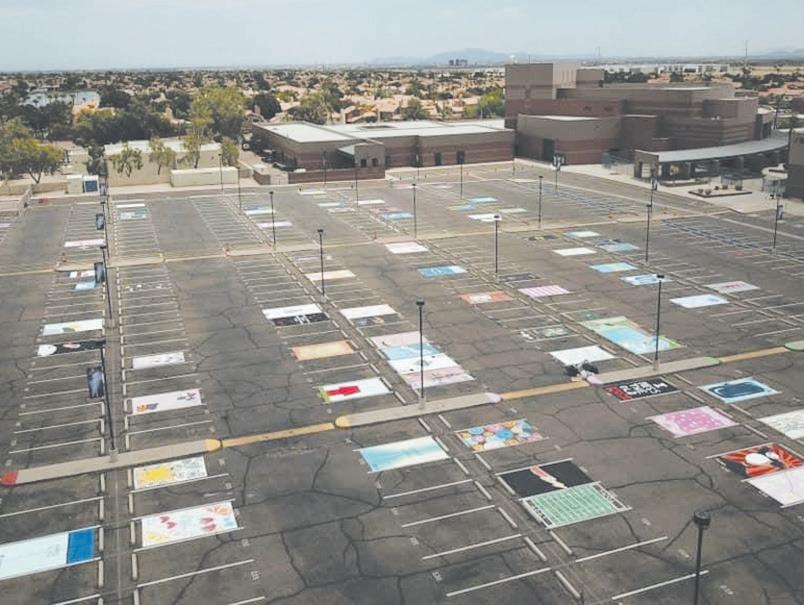
The AMA Room at Lights Camera Discover in Ahwatukee has scheduled four big community events – including three that cover just about the whole day this Saturday, Aug. 12.
For starters at the AMA Room, 4825 E. Warner room, Chicago Bears and Tennessee Titan fans can watch the first pre-season football game with doors opening at 9:30 a.m..
Giveaways and $5 drink specials and food for purchase from Tom’s BBQ and Famous Chicago Dogs also will be available.
Stick around from 1-4 p.m. for the “Sip and Shop” event, where shoppers can buy from local vendors and food and drink vendors will have specials for purchase. The event is free and $20 for vendors.
Offering “good clean fun by local comedians,” Lights Camera Discover, 4825 E. Warner Road, Suite 13, will hold the Ahwatukee Comedy Night Saturday with doors opening at 6:30 p.m. and the
BUY AT THE FACTORY & SAVE FACTORY SHOWROOM
OPEN TO THE PUBLIC
100% COMPLETE KITCHEN REMODELING FREE ESTIMATES
STONECREEKFURNITURE.COM
200 S KYRENE RD CHANDLER AZ (602) 458-9800 ROC208075 ROC 279455

show at 7 p.m.
There will be food specials by Holy Empanadas. Tickets are $10.
The AMA Room also plans an End of Summer Party noon-5 p.m. Sept. 3. Vendor spaces are $20 and admission for partiers is free. Information: LCDAMAendofsummer.eventbrite.com.
Friends and Neighbors group invites Ahwatukee women
Ahwatukee women looking to make new friends and join a variety of activities care invited to the next Ahwatukee Foothills Friends and Neighbors breakfast brunch at Sivlik Grill 10 a.m.-1 p.m. Aug. 28. The guest speaker is Carrie Chipman, who runs Country Collective Travel Club where she escorts groups all over the world.
Contact Pam Oliver at pamoliver614@ gmail.com or text/call 614-205-2243 for details and to register. The cost of the lunch is $22 and must be prepaid by Aug. 19 to attend.
Information: affanwomensgroup. org/public.
Breakfast with Democrats includes raffle baskets
LD12 Democrats & Donuts meets at 8 a.m. on the third Wednesday of each month at Denny’s, 7400 W. Chandler Blvd., Chandler.
It includes speakers and raffle baskets by Judy Wade. The Aug. 18 speaker is Ricardo Serna, president of the Maricopa County Young Democrats.
Get there a little earlier to order breakfast. The hosts will be there by 7:30 a.m. Information: juliafleeman@ cox.net.
‘Arizona Nutcracker’ auditions this weekend at Dance Studio 111
Ahwatukee Dance Studio 111 founder-owner Kimberly Lewis is preparing for the her 24th annual presentation of the holiday classic with open auditions Saturday, Aug. 12, for this year’s “Arizona Nutcracker.”
For over two decades, her production was called “Ahwatukee Nutcracker,” but to reflect the Valley-wide interest by dancers and others in performing, Lewis rebranded the show, though it re-
see AROUND page 33
AROUND from page 32
mains the only “Nutcracker” featuring a cast fully made up of kids ages 3-21.
It will be presented Dec. 16 and Dec. 17 at the state-of-the-art Madison Center for the Arts at 5601 N. 16th St., Phoenix.
Auditions will be held at Dance Studio 111, 4910 E. Chandler Blvd., Ahwatukee.
While auditions will be held for ages 3-21 Aug. 12, Lewis also is scheduling free Arizona Nutcracker Ballet Prep Classes for the two days prior to that.
On Aug. 10, kids 11 and over can join for lessons 4-5 p.m. while advance level lessons for ages 14 and up will be offered 5-6 p.m.
On Aug. 11, ages 3-4 are welcome for lessons at 3:15-4 p.m., followed by ages 5-7 at 4-5 p.m. and ages 8-10 at 5-6 p.m.
Space is limited for the classes and parents should reserve a space by emailing arizonanutcracker@gmail. com.
The auditions are open to anyone between 3-21 and hopefuls do not have to be Dance Studio 111 students.
Audition times Aug. 12 are: 9-10 a.m.,
ages 3-5; 10-11 a.m., ages 6-9; 11 a.m.noon, ages 10-13; noon-12:30 all boys; and 12:30-2 p.m., boys and girls ages 13-21.
Girls should wear black leotard, pink tights, ballet or pointe shoes and hair pulled back in a ballerina bun. Boys should wear black shorts and white Tshirt.
Information: dancestudio111.com.
Fundraiser for annua Christmas lights display is underway
Christmas may seem a long way off, but for the volunteers helping out with the 2023 holiday lights along Chandler Boulevard, raising the money needed to put on the show starts now.
For the third consecutive year, the Foothills Community Association HOA will be overseeing the holiday lights along Chandler Boulevard. As the largest financial contributor to the display, the HOA has started its fundraising now before hiring the contract winner in September.
“If insufficient donations are received
see AROUND page 34
Call or visit your local financial advisor today.
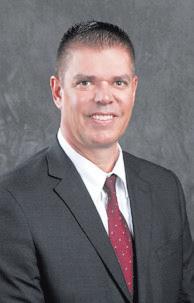
* Annual Percentage Yield (APY) effective 07/12/23. CDs offered by Edward Jones are bank-issued and FDIC-insured up to $250,000 (principal and interest accrued but not yet paid) per depositor, per insured depository institution, for each account ownership category. Please visit www.fdic.gov or contact your financial advisor for additional information. Subject to availability and price change. CD values are subject to interest rate risk such that when interest rates rise, the prices of CDs can decrease. If CDs are sold prior to maturity, the investor can lose principal value. FDIC insurance does not cover losses in market value. Early withdrawal may not be permitted. Yields quoted are net of all commissions. CDs require the distribution of interest and do not allow interest to compound. CDs offered through Edward Jones are issued by banks and thrifts nationwide. All CDs sold by Edward Jones are registered with the Depository Trust Corp. (DTC).
FDI-1867L-A © 2022 EDWARD D. JONES & CO., L.P. ALL RIGHTS RESERVED. AECSPAD
FDI-1867L-A © 2022 EDWARD D. JONES & CO., L.P. ALL RIGHTS RESERVED. AECSPAD











this summer, the lights display could be reduced for this year,” volunteer Carrie McNeish said, adding the HOA has raised its goal by $50,000 to $100,000.
Sponsors can email McNeish at cmcneish@cox.net and donors can go to gofund.me/e9ced0b2 .
Besides the Foothills HOA, the Club West HOA also is a sponsor along with the Festival of Lights Committee, SanTan Ford and Safeway/Albertson’s.
Sponsors are entitled to several benefits, including a mention on the two homeowners associations’ websites and in the Ahwatukee Foothills News.
To donate by check, make it out to the Foothills Community Association with “Foothills Holiday Lights Donation” in the memo field. Mail it to: RealManage, Attn: Cathy Van Galder, 3930 S. Alma School Road, Chandler, AZ 85248.
Grand Golf Course in Ahwatukee with a 7:30 a.m. shotgun start.
Sponsors are also needed. Three sponsorship levels are available with each carrying a variety of benefits.
Knights of Columbus 10062 Charities, Inc. is a 501(c) (3) organization. Call 480-250-2208 and leave a callback number or visit kofc10062.org to download registration and sponsorship forms.
Nonprofi t weight-loss support program at Rec Center
A TOPS (Take Off Pounds Sensibly)
Club chapter is meeting at 6 p.m. every Wednesday in the board room at the Ahwatukee Recreation Center, 5001 E. Cheyenne Drive. It’s preceded at 5:30 p.m. by socializing and optional weighin charts.











Corpus Christi Knights of Columbus to hold golf tourney
Confident the heat wave will ebb by September, the Corpus Christi Knights of Columbus Council 10062 is asking golfers to save Sept. 9 for their annual Memorial Golf Tournament.
This year’s tournament honoree is Jim McGrath and this is Knights’ 32nd event.
Proceeds will benefit Knights’ Charities, the K of C Ukraine Solidarity Fund and Folds of Honor Arizona, a nonprofit providing scholarships to qualifying family members of fallen military and first responders.
Registration is taking place now and includes a full round of golf, beverages, cart prizes and lunch for $140 per player.
The tourney will be at the Arizona
The club was formed in Wisconsin in 1948 and has grown over time to become an international organization. The 28-year-old Ahwatukee club offers education, fun contests and sharing of weekly progress at its meetings “without negative judgments.”
For more information, contact Meg Hoffman at 602-486-9100.
Ahwatukee Toastmasters offers growth opportunities
For over 35 years, the Ahwatukee Toastmasters has maintained a continuous presence in Ahwatukee, providing the know-how, practice and encouragement to help members improve their communication and leadership abilities.
Toastmasters meets 7-8 a.m. every other Tuesday at Esperanza Lutheran
see AROUND page 35


Church, 2601 E. Thunderhill Place, Ahwatukee. For more information, call or text Ed Prestwood at 480-603-8359, or search Ahwatukee Toastmasters. The group’s chair is Jianhong Zhou, who can be contacted at smiqua.zhou@ gmail.com.
Ironwood Library offers free activities for all ages in August
Ironwood Library, 4333 E. Chandler Blvd., Ahwatukee, presents a variety of programs for children, teens and adults. Unless otherwise noted, no tickets or registration is required.
Information: phoenixpubliclibrary. org.
Babies ages birth to 23 months, accompanied by a favorite adult, will enjoy songs, rhymes, books, and interactive fun Tuesdays 10:30-11 a.m. Free tickets are required and available 30 minutes before programs’ start times at the library’s information desk.
Toddlers ages 24-36 months, accompanied by a favorite adult, will enjoy songs, rhymes, books, and interactive fun Thursdays, 10:30-11:10 a.m. Free tickets are required and available 30 minutes before programs’ start times at the library’s information desk.
Young readers and listeners can sign up for reading time with a registered therapy dog/handler team. Read with Elsa every Tuesday, 4-5 p.m. Read with Raven Thursday 4-5 p.m.
Children ages 6-12 explore hands-on creative ways to design, experiment, and invent Aug. 12 and 26, 2-4 p.m., in this drop-in Science, Technology, Engineering, Art and Math (STEAM) program.
Join fellow stitchers Aug. 19, 3-4:45 p.m. Knitting, crocheting, cross-stitch, needlepoint and all are welcome.









Golden Belt Roofing’s owner Brad Crone says education is the key to successful relationships with his clients.
“I like helping them,” Crone said.
“I like explaining to them why they need a new roof and what happens to their roof before and during the repair/replacement process. I’m very knowledgeable. I can give them a good product. I can do a good job. I treat everyone’s house like it’s my own.”
Crone didn’t get into roofing because of a family member. His reasons were simple: The career paid well, and he was looking for a solid career.
“I also liked that I would be working outside with people in the community,” he said.
Crone, who obtained his license in 2014 in Kansas, is an industry veteran. He started in roofing sales and segued into contracting.
“I had an opportunity to become a salesman for a company back in 2011,” he said. “That company didn’t hold up to their end of the bargain. It was always hard to receive my commission. I did that for about three years before I decided to get my roofing license and go into business for myself. I
haven’t looked back.”
Crone is certified in tile, TPO (thermoplastic polyolefin), standing seam and asphalt shingles.
With Golden Belt Roofing, Crone and his crews perform roof repairs, new roof construction, roof replacements and preventative maintenance.
“My crew is top notch, and I wouldn’t trade them for anything,” he added. “My priorities, in order, are the homeowner always comes first. My crew is a close second. The only reason the crew is second is because it is my and my crew’s job to take care of the homeowner.
“I have to take care of those two first. Then I think about the business, which is in business to make a profit. But it can’t survive without the homeowner or the crew.”
Golden Belt Roofing also offers free inspections and estimates, and Crone is schooled in insurance claim management. He said he promises on-time service; trained and quality crew members; fast turnarounds; extended warranties and money-saving solutions.
“I’ve learned quite a bit over the years — what to do, what not to do, what makes customers happy, what makes customers unhappy,” he said.
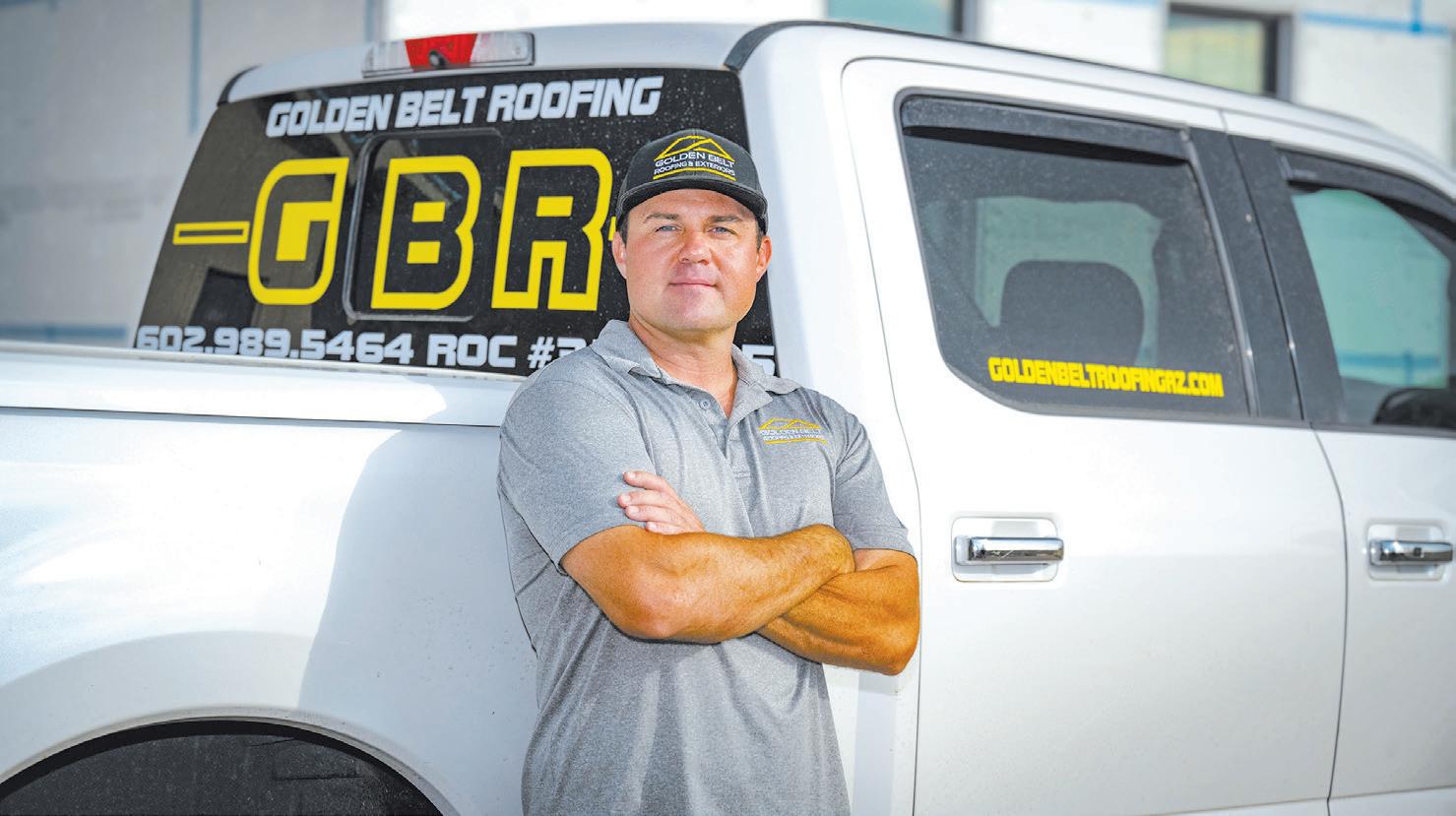
Golden Belt Roofing owner Brad Crone, who obtained his license in 2014 in Kansas, is an industry veteran. He started in roofing sales and segued into contracting. (Dennis Murphy/Special to AFN)
“I stress quality over quantity. I enjoy giving the homeowners the most professional job they can get for a fair price.”
Although Crone is experienced in commercial projects, he focuses on residential tile and underlayment replacement. In Kansas, he worked on storm restoration work — roofing, siding, windows and guttering. Wanting to focus on roofing, he moved to Ahwatukee, where he is embedded in the neighborhood.
“It’s amazing to me to come here and only do tile roofs,” he said. “I want to make sure clients know they’ve hired a great professional who will help them through the process. I consider myself a true professional.”
Golden Belt Roofing
602-989-5464
goldenbeltroofingaz.com
info@goldenbeltroofingaz.com
Times Media Group President Steve Strickbine has announced that his company has acquired Picket Fence Media’s award-winning Southern California brands.
Times Media Group publishes the Ahwatukee Foothills News, among numerous other weekly newspapers and monthly magazines in the Phoenix and Tucson markets.
Picket Fence Media publishes the weekly San Clemente Times, Dana Point Times and the bi-weekly Capistrano
Dispatch (covering San Juan Capistrano and Rancho Mission Viejo).
The group joins Times Media Group’s other Southern California community news properties, including the Pasadena Weekly, LA Downtown News, The Argonaut in Santa Monica and the Ventura County Reporter among others.
“We are very excited to expand our footprint into these thriving communities, providing news and information to readers as well as opportunities for advertisers with the same high standards of excellence Norb Garrett and his team
have established over the past 17 years,” said Strickbine.
Media executive and entrepreneur Garrett founded Picket Fence in 2006.
The company consists of the newspapers, websites, social media channels, custom magazine publishing and enewsletters.
Last year, The Dana Point Times earned the prestigious CNPA California Journalism Award for General Excellence for weekly newspapers.
PFM has been at the fore of great journalism in the SoCal area for most of its
history, having earned nearly 100 editorial awards since the San Clemente Times, its original newspaper, launched in 2006.
PFM’s media products cover the desirable coastal and historic South Orange County communities of San Clemente, Capistrano Beach, Dana Point, San Juan Capistrano and Rancho Mission Viejo.
“Steve and I share the same belief in the power and importance of original, hyper-local community journalism,” said Garrett, who along with his wife and





AFN NEWS STAFF
And Ahwatukee executive for Cox will lead the Greater Phoenix Chamber of Commerce’s Diversity, Equity and Inclusion Committee.
Jeannine Watanabe, director of network operations for Cox Southwest Region, will spearhead the committee’s work in helping companies “maximize the benefits of culture, root out unconscious bias, celebrate diversity, hire diverse employees, support marginalized communities and learn about new cultures,” Cox said in a statement.
Watanabe co-chairs the Cox West Inclusion, Diversity, Equity Council and previously served as the co-chair of the People Pillar for Diversity and Inclusion. She has developed new programming
SOCAL from page 36
general manager, Alyssa, have operated PFM since its launch.
“By merging our businesses together and leveraging the deep resources of
for Cox employees, including monthly VP Coffee Talks and a Journal Club.
As a trained facilitator, she is also active in the Action Speak series to help employees become more comfortable in discussing social injustice.
At Cox, Watanabe is responsible for 27 network engineering facilities and a team of 90 people that deliver its business and residential services to their customers.
“She is adept at leveraging numbers to drive business decisions while creating a culture of accountability,” Cox said in a release.
Watanabe is a 2nd degree black belt in Tae Kwon Do, a “voracious reader and loves traveling to continue to learn about other cultures,” according to the company.
Times Media Group, I believe we’ve secured a bright future for The San Clemente Times, Dana Point Times and The Capistrano Dispatch. I believe we’ve found the perfect match for Picket Fence Media’s brand ambitions.”
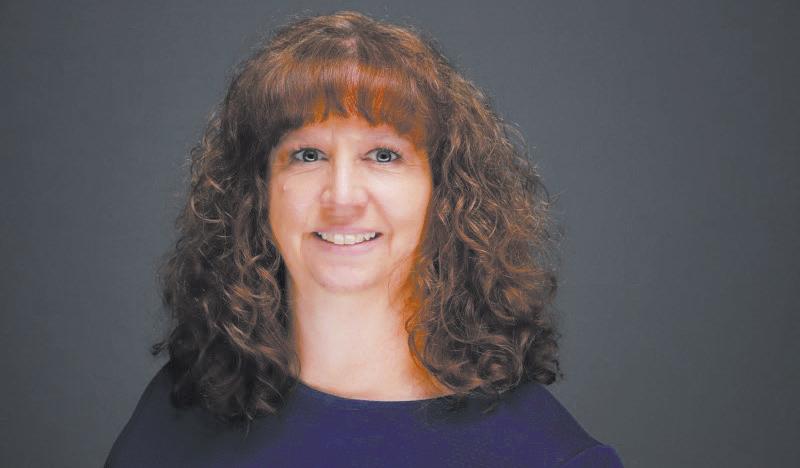
Times Media Group will continue to operate the Picket Fence Media publications from PFM’s address in Capistrano Beach. Times Media Group, founded in 1997 by Strickbine, owns and operates more than 35 publications throughout Ari-
zona and Southern California, including more than 25 weekly community newspapers and companion websites.
TMG also owns and operates AZ Integrated Media, a media distribution and custom publishing company.








The process of a major company opening an office or moving its headquarters to Chandler takes years.
Mayor Kevin Hartke said because secrecy in these deals is so important, companies use code words so information about their plans doesn’t leak out.
“There’s always a creative code name to the unveiling of a company,” Hartke said July 27 at one such ribbon cutting.
“For that, we want to be known as a city that says ‘YES’ to businesses coming into our community.”
Hartke was speaking at the ribbon cutting of Yield Engineering Systems (YES), which was previously known as code name COAT for the past three years.
The semiconductor company is bringing more than 100 jobs to start to its new facility in the Price Corridor on Germann Road, just west of Price Road.
The state-of-the-art YES Advanced Technology Center will include 50,000-square-feet of manufacturing space for semiconductor manufacturing and process development.
There will also be a 10,000-squarefoot cleanroom in the first development phase that will be quadrupled in size down the road.
“The cleanroom will allow YES to collaborate with its customers to develop innovative processes and validate platform prototypes,” the Arizona Commerce Authority said.
CEO Ramakanth Alapati said YES settled on Chandler for three main reasons –the city’s and the state’s business-friendly attitude; schools capable of producing the skilled workers they need; and because it’s where their clients are located.
Like Intel, one of YES’s clients. Chandler Economic Development Director Micah Miranda estimates at least 50,000 non-Intel employees can thank the semiconductor giant for their jobs.
Hartke said it may be even more than that.
He said Chandler Fashion Center only announced it would open after Intel an-
nounced plans for its Ocotillo campus in the 1990s. Hartke said even fast food workers and others in the service industry can thank Intel for their jobs.
“Intel estimates there is a Five-X effect,” Hartke said. That means for every job Intel has, there are five others created to support the company or its employees.
YES creates technologies that improve the semiconductor process. As such, it does a lot of research and development.
The company says it can reduce by 99% the hazardous chemicals used in coating, noting 70% of the world’s genome sequencing is done with its technology.
And YES has technology most Americans have in their pockets or purses. It says 80% of the world’s advanced fan-out processors for smartphones are made with YES equipment.
“For over four decades, YES has been at the forefront of research and development that has pioneered new equipment used in semiconductor fabs throughout the world,” the Commerce Authority said, noting:.
“Its portfolio encompasses cuttingedge technology and innovative hardware that drives advancements in multiple industries, from artificial intelligence and high-performance computing, to life sciences and mixed reality applications.”
The company has its world headquarters in Fremont, California, and Chandler is its third U.S. location. It also has operations in India, Germany, Taiwan, Korea and Japan.
“Our primary focus is materials, modifications and surface enhancement,” Alapati said.
Alapati and others credited the 2022 CHIPS and Science Act passed by Congress and signed into law by President Biden for YES’s move to Chandler.
The law provided about $280 billion to encourage domestic research and manufacturing of semiconductor chips. Arizona Senators Kyrsten Sinema and Mark Kelly and Congressman Greg Stanton all sent recordings played at the ribbon cutting, crediting the act for helping bring YES to Chandler.





The Arizona sun beat down on the pavement in May, hot enough to make any walking person uncomfortable. Summertime was on the horizon. Before the thermometer reached scalding temperatures, the Readinger residence hosted a graduation party.
Addi Readinger appeared set to begin the next stage of her life after her senior year at Millennium High School in Goodyear. Some guests quietly noted she looked thinner. They likely chalked it up to the cardio required to compete in track and field, cross country, basketball and soccer.
Gold and black graduation decorations adorned the house, and the smell of food permeated the air. Guests munched on hot dogs, hamburgers, mac ‘n’ cheese and chips. Readinger ate none of it.
She always had been the center of attention on her track teams, winning just about everything, and to her discomfort, today was no different.
“Everybody was like, ‘What’s your next step? What are you gonna do?’” Readinger said. “I had a graduation party and didn’t graduate. I was so ashamed that I didn’t tell anybody.”
Nor did they know the former 3.8 GPA student taking honors and AP classes had only attended school about once a week, and only for a portion of the day.
“I don’t think they would even believe me,” she said.
As a result of a dizzying amount of external pressures, Readinger developed an eating disorder. In about a month, she dropped from 136 pounds to 102 pounds.
Nearly half of Americans struggle with a mental illness for some period of time before they reach adulthood, and young athletes are no exception. Athlete adolescents are reporting “higher levels of negative emotional states” than their non-athlete counterparts, according to a 2015 study from the National Athletic Trainers’ Association.
“Keeping up with (your) mental health is something that you really have to rely on,

As conversations surrounding mental health of high school student-athletes continue, many stigmas remain. Athletes face more pressure from peers, coaches and parents, yet some still hesitate to reach out when struggling. (AFN File Photo)
especially when it comes to school and doing sports,” said Malakai Dotstry, a former track and field athlete and football player at Youngker High School in Buckeye. “Because if your mental health is not right, you’re not going to do your work at your best.”
Competing with a group or team is generally seen as a positive for self-worth, but stress is present over individual performance, playing time, dealing with aches and sprains and bruises, or pleasing teammates, coaches and parents. These factors can compound themselves with the normal stressors for teenagers, like turning in school assignments on time, working a job after school or making time for friends.
Readinger had a busy schedule balancing all her sports and extracurricular activities. From freshman to junior year, a typical day included waking up at 5:30 for practice, attending school during the day, more practice in the evening, work from 6 to 10 at night, finally catching some sleep around midnight, then rinse and repeat.
Despite how hectic this could seem for anyone, let alone a teenager, Readinger managed to make it all work. She had the friends she grew up with and her church group for support and was succeeding academically and athletically. Everything was going well. But midway through her junior year, her family moved to Arizona and Readinger no longer had her support systems in place.
As a result, life took a turn for the worse.
The 2010s marked the advent of the social media age. The ability to connect with anyone in the world was available at the push of a button. A time so unimaginable even 20 years before, it will likely go down as one of the major eras (and maybe errors) in human history.
Social media usage has been linked to higher rates of depression, anxiety and lower self esteem. Seeing images of a projected perfect life can make one’s perception of their own seem not as exciting and their bodies not fit enough in comparison.
“For any teenager, social media plays at least 50% of the cause for their mental health struggles,” said Rajani Rastogi, who worked as a social worker at Hamilton High School in Chandler for almost nine years. “Their self-esteem suffers because of what other people are doing and saying online.”
Social media usage also contributes to a lack of sleep in teenagers, which can ultimately lead to mental health disorders.
Of course, it is possible for students to seek help from someone like a school counselor or social worker.
But even with all the resources available, it doesn’t mean they have the familiarity with these resources to feel comfortable reaching out. Going into a vulnerable state and telling them everything going on can be hard because they don’t know the person.
“I think maybe some athletes feel like, ‘Oh, I can handle things on my own.’ They feel more tough, or they rely upon the
coach and their team,” Rastogi said. “It depends on everyone’s comfort level.”
It’s important for coaches to foster an environment where athletes feel comfortable enough to come forward with their problems. Through 21 years of coaching, Keiko Yoshimine has seen everything from a winless season to a runner-up for a Coach of the Year award.
Yoshimine and Kristin Hoffner, a principal lecturer at ASU teaching sports psychology, were head coach and assistant coach, respectively, of the girls varsity basketball team at Paradise Valley from 2004 to 2012.
They were a bad team at first. Routine losses of 30 points or more and a 1-47 record across two seasons highlighted their struggles. Often, players would come to Yoshimine and Hoffner complaining about not only the mental stress of losing so often and by so much, but bullying from classmates who had seen the scores.
Some players had other issues outside of basketball which would affect their performance on the court. Namely, there was an incident where one girl had been cutting and another who had been suffering from an eating disorder and passed out during practice.
“It was always about keeping the lines of communication open,” Yoshimine said. “There were a few kids that have had to have sit-downs with parents and talk about what we’ve been seeing or what we think is happening. You’re trying to give that kid support.”
Yoshimine and Hoffner weren’t experts on the mental health of teens, just a pair of high school basketball coaches in their mid-twenties.
Awareness of athlete mental health has changed.
Gymnast Simone Biles and swimmer Michael Phelps have been praised for coming forward about their mental health issues. But at the same time, the stigmas persist.
“It takes you a while to figure out that you’re even feeling that way and realize it’s a problem, and at that point, you’re probably too embarrassed because you’ve been telling people for so long it wasn’t a problem,” Readinger said.


Mattel Adventure Park is under construction in Glendale, but kids can get a sneak peek of what’s to come with Hot Wheels Monster Truck Live Glow Party at Desert Diamond Arena.
Engines will roar and hearts will soar at the event, which features Bigfoot, Mega Wrex, Tiger Shark, Boneshaker, Gunkster and other Hot Wheel favorites on Aug. 19-20.
e monster trucks will take the Desert Diamond Arena oor for competitions and battles, but a highlight will be a “dazzling dance party, spectacular laser light shows and Hot Wheel toy giveaways.” Hearing protection is advised.
Plus, for the rst time, the re- and frost-breathing, car-eating dragon Arcticgon, will make an appearance.
Rebecca Schnell has been with Big-

foot’s team since 2019 but had her rst monster truck experience as a child. anks to a meet and greet she attended, she met her future husband Darron
In case you didn’t know, August is National Romance Awareness Month while Aug. 14 is Romance Awareness Day, according to the Ahwatukee Melting Pot.
One website, daysoftheyear.com, explains the month “o ers a moment to re ect on your relationship.”
“With summer ending and the stress of the holidays around the corner, this month is perfect for helping you and your partner realign, while growing closer together,” it adds.
“ is is a great time for couples to try adding a little spark to their relationship,” it states. “Plus, it’s been six months since Valentine’s Day, so it’s time to re-
member again.”
While the website advises couples they can observe the month by doing things like reading a romance novel or watching a romantic movie and even “learn about the bene ts of romance,” the Melting Pot has what it thinks is a better idea.
It certainly might be a little tastier than watching “Casablanca” or reading “Pride and Prejudice,” as daysoftheyear suggests.
e Melting Pot, 3626 E. Ray Road, suggests people try its specially designed romantic fondue every ursday – which it calls “ ursdate.”
e romantic mealis a four-course dinner, starting at $69, that includes a
Schnell.
“I climbed into the monster truck when I wasn’t supposed to,” Schnell said. e rest was history. Before she was a
driver, she spent time on the road helping Darron with his Bigfoot 19.
“Everything we do on a regular car we have to do for a monster-sized vehicle,” Schnell said.
“It’s a lot of work in a lot of trouble but a heck of a lot of fun.”
After dedicating her time to maintaining Bigfoot 19, Schnell had the chance to drive her own.
“I was a little nervous at rst,” Schnell admitted.
Competitions usually include races on rough terrain, a skills challenge to show o their best stunt, a doughnut competition and a freestyle competition that allows each driver to show o . roughout the games, the giant Hot Wheels jump over and demolish smaller cars.
“It’s kind of funny but I closed my eyes the rst time I hit a set of cars,” Schnell

choice of handcrafted cheese fondue, fresh salad course, and entrées like including tender let mignon, Atlantic salmon or savory teriyaki steak.
Topping it o is “a sparkling chocolate
fondue ending.”
“Of course, the perfect date night is all about the details,” spokeswoman Jackie
There’s an adage about breakfast being the most important meal of the day and the operators of Chandler’s newest Over Easy location believe the folks serving it can in uence your whole day.
“ ey really want to get to know the people, having good times and spark brighter days,” said Jennifer Savage, the general manager of the Over Easy in e Shoppes at Casa Paloma at Ray Road and Interstate 10 in West Chandler.
at location o cially opened on June 24, becoming the second in the city and 11th in Arizona. e other Chandler location is downtown in the Overstreet development.
e good vibes – what Over Easy calls its Rays for Days – are just one of the draws that have helped the company grow.
“It’s a scratch-made kitchen. All the food is made from scratch,” Savage said.
So that’s the secret to their success?

Over Easy will be opening its 12th Arizona location in Glendale next month.
“It’s a combination of both,” said Olivia Crane, the company’s hospitality manager. “You can get great food anywhere, but service is just the bow on the top, the cherry on the cake. It’s something that’s rare, I guess, nowadays.”
Savage said the food also is a draw. For


example, lots of places o er biscuits and gravy for breakfast. But not as many use homemade cheddar and jalapeño biscuits and gravy with a bacon avor.
e top seller on the menu is the twoegg breakfast, which includes two eggs served any style. It comes with a choice of potato, toast and either applewood smoked bacon, sausage links, ham steak or maple chicken sausage.
Another favorite is the Golden Wa e Dogs, which has three sausage links dipped in vanilla wa e batter and fried to a golden brown.
One other dish tends to stand out with visitors, Savage said, and that’s the chicken fried steak. e hand-made batter covers the steak and the bacon- avored gravy are the highlights. e dish comes with two eggs and a choice of either potato or toast.
Many of the dishes have been featured on reality TV cooking shows.
Savage said Over Easy relies on its employees to bring good vibes and high energy every morning to help customers get their day o to a positive start.
She said they have not struggled to nd those employees like others in the restaurant industry have.
“I will tell you I’ve worked at quite a few throughout my years, and we haven’t struggled here at all,” Savage said. “All of the Over Easys seem to be fully sta ed.
“It’s a great company. at’s why people come in, and they stay. ey don’t leave.”
So far, the new location is quite popular, Savage and Crane said. ey said many of the stores near them focus on healthy food and while there are quite a few restaurants, not many focus on breakfast.
at, the scratch food and the good vibes have led to a busy restaurant so far.


POT from page 41
Rodriguez advises. “Each table is set with rose petals and candles for that extra special touch.”
And it can include “ ursdate Sweet Talk – fun and irty conversation starters” that are part of a suite of digital conversation starters that help couples learn more about each other – or, presumably re-learn what they forgot.
7131 W. Ray Road, Chandler 480-306-6681
eatatovereasy.com
Jennifer Savage, left, and Olivia Crane welcome diners to the new West Chandler location of Over Easy. Savage is the general manager of that location and Crane is the hospitality manager of the company.
Sweet Talk is accessed through a QR code once couples are seated at their table and includes anything from lighthearted questions such as, “What is your favorite item dipped in melted chocolate?” to more serious queries like, “What can I do more often to make you feel appreciated?”
To learn more and re up those ames of romance: meltingpot.com.
TRUCKS from page 41
said. “Your brain doesn’t understand that when you’re strapped into a big machine like this, that it really doesn’t hurt. You have to train your brain a little bit in order to get used to that impact.”
On top of her career of driving Bigfoot 15, Schnell is a traveling emergency room nurse. She’s able to juggle the two adrenaline-packed jobs.
“I’m moving from one career of making these highlight monster truck memories to seeing and helping people on their worst days,” Schnell said, “I love sharing behind-the-scenes footage of the daily life of a monster truck driver and ER nurse.”
Schnell holds herself to a personal standard of becoming the role model kids and parents want to see when they look at a Hot Wheels driver. Meeting and talking to fans at the Hot Wheels Crash Zone Pre-Show Party is Schnell’s favorite part. e generational love for monster
trucks and Hot Wheels is “is an honor to be a part of,” Schnell said.
When the Mattel Adventure Park construction is done, fans will be able to ride roller coasters, drive go-karts and visit themed spaces that feature the monster trucks, Barbie, and omas & Friends.
“Pretty much every little boy and girl grew up with something from that Mattel brand and being back in Glendale and seeing the park coming to life is really great,” Schnell added.
When: 12:30 p.m. and 7:30 p.m. Aug. 19; 2:30 p.m. Aug. 20
Where: Desert Diamond Arena, 9400
W. Maryland Ave., Glendale
Cost: Tickets start at $30
Info: hotwheelsmonstertruckslive.com, desertdiamondarena.com







ACROSS
1 Glasses, slangily
6 Acid type
11 "Cut that out!"
12 Alphas' opposites
14 He loved Roxane
15 Not certain
16 PC key
17 Blue Grotto isle
19 Hearty qua
20 Floral rings
22 Vat
23 Peevish fit
24 Song of praise
26 Olympic skater Brian
28 "Certainly!"
30 Away from SSW
31 Mexican chili pepper
35 Labrador explorer
39 Nashville venue
40 "A spider!"
42 "-- Breckinridge"
43 Fib
44 King of Judea
46 Taunting laugh
47 Captivate
49 Comic Ray
51 Bagel choice
52 Retaliate
53 Trusty horse
54 Dweebs
DOWN
1 Fashions
2 Shakespearean heiress
3 Ecol. watchdog
4 Title akin to POTUS
5 Brown ermine
6 Kentucky brew
7 Hotel chain
8 In medias --
9 Big lizard
10 Comedian George
11 Overcharge for tickets
13 Handle
18 Tavern
21 In a sneaky way
23 Fulton's power
25 -- culpa
27 Business mag
29 Showed scorn
31 Fishing rods
32 Speaks one's mind
33 Chicken serving
34 "-- the ramparts ..."
36 Manually
37 Arboreal apes
38 Western resort lake
41 Imam's holy book
44 Abode
45 Peace symbol
48 Astronaut Jemison
50 Mal de --


As the old adage goes, what’s old is new again. In this case, a cheese that has been enjoyed for hundreds of years in another part of the world, Cyprus, is now trending here America.
Halloumi is a fan favorite for foodies, who love the idea of grilling cheese and adding it to a boozy mixture of dried fruits happily soaking in sherry.
This ancient cheese is emerging as a foodie favorite

The cubes of grilled halloumi emerge as the surprise savory bite amid the sweet and spirited chutney-like combination, made all the better when it’s spooned on a slice of charred crusty French baguette. Halloumi is a semi-hard cheese that can be made from goat, sheep or cow’s milk. What makes it perfect for this dish is that halloumi, known for its chewy texture and tangy taste, has an extremely high melting point, so it can easily be grilled without melting.
There are many ways to enjoy Halloumi, but this is by far my favorite. This dish is simple to prepare yet it yields
Ingredients:
• 1 loaf ciabatta bread
• 2 tablespoons butter
• 2 tablespoons olive oil
• 2 blocks Halloumi cheese, cubed (8 ounce blocks)
• 1-1/2 cups Sherry wine
• 1/2 cup butter
• 4 ounces dried cherries
• 4 ounces pitted dates, rough chopped
• 4 ounces dried apricots, rough chopped
• 4 ounces dried figs, rough chopped
• 1 teaspoon salt
Instructions:
Heat a grill pan to high. Slice the ciabatta bread into diagonal slices. In a small bowl, combine the
complex flavors from the first bite to the last. You can always find halloumi in Middle Eastern grocery stores like Caspian Market in Scottsdale and Baiz Market in Phoenix. But it’s becoming more likely that you’ll find halloumi in your regular grocery store. Please avoid the temptation to buy cooking sherry in the baking aisle. This recipe deserves a nice (and it’s inexpensive!) bottle of Sherry from the wine section of the store. Halloumi is becoming a rising star in the food trend universe, and this is the type of dish that will keep its star on the rise.
butter and olive oil. Brush the slices with the oil butter combination. Place slices on hot grill and char, about 4 minutes on each side.
Remove and set aside. Slice each block of halloumi into 8 (1-inch) strips. Place halloumi on the same hot grill and cook to get grill marks on both sides, about 2 minutes per side.
Remove and cut the slices into cubes. In a large skillet over medium high heat, combine the sherry, butter, dried cherries, dates, apricots figs and salt.
Cook until fruit has softened and sherry and butter have created a slightly thickened sauce, about 8 minutes. Add the halloumi cubes and cook for another 3-4 minutes. Serve in a shallow bowl with slices of charred bread. Serves 8.

































